SSC Courses and Programs:
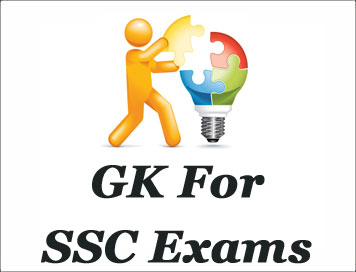
General Knowledge for SSC Exams (Modern Indian History)
The period from 1707 AD, the year when Aurangzeb died, to
1857, the year of the Indian uprising. saw the gradual increase of the European
influence in India. The Europeans had been filtering into India for a long time
before they actually decided to set up shop here. Even though the British got
away with the jackpot. the real pioneers to reach India were the Portuguese.
Full of crusading and commercial zeal, Vasco di Gama was the first known
European to reach India in 1498, even before the Mughals arrived here. When
Vasco di Gama docked his ship in Calicut, he announced that he came in search of
“Christians and spices” and the very first people he met here were Christians,
who were descendants of those who had settled in India way back in the 4th
century AD.
Portuguese Rule
The Portuguese settled down to a very prosperous trade in
spices with India. The Muslim rulers in Delhi and then the Mughals never really
warmed up to the idea of a foreign power continuing trade on the seas under
their imperial noses. What’s more, they were not exactly very honest traders
too, since they thought that no word that was given to an infidel need be kept.
So much so that the word phirangi. or foreigner in colloquial, came to be a
hissing and a byword among locals. In fact in Goa, where the Portuguese ruled,
intolerance levels ran high and even the building of Hindu temples was banned.
Alberquerque (1509-1515), who was the second Portugese viceroy in India,
encouraged mixed marriages with the sole object of creating a mixed race who
were Portuguese Catholics, and who would be bound by race and culture to the
Portuguese. They were known as Luso-Indians at one time and now simply as Goans.
Advent of Dutch
The Dutch came shipping in the East for the first time in
1595. However, they did not come to India initially, and established themselves
at the helm of things in the spice trade in Jakarta. India carne into the
picture for them purely as a route to Europe, as part of a great Asian trade
route that they developed which went through Ceylon and Cape Town. Although the
Dutch had their factories dotting all over in Cochin, Nagapatam and even up in
Agra) they did not attempt to gain military power, being quite content to gain
in cash.
French Invaders
Although the French King Locus XII had granted letters of
monopoly to French traders in 1611, it was not until December 1667, that a
French company was actually set up in India. This was at Surat (in Gujrat) with
Francis Caron as its Director-General. Soon, in 1669, another French company
came up in Masulipatnam, thanks to a grant by the king of Golconda. which
exempted the French from paying import and export duty. In 1672, Caron’s place
was taken by Francis Martin, who is regarded as the real founder of the French.
English Formed East India Company
The English, formed their East India Company on the last day
of 1600 and entered the East India hand in hand with the Dutch. Their foes were
common-the Portuguese and Catholic Spain and this brought them closer. However,
familiarity breeds contempt, and soon the English realized that the Dutch were
not willing to share their space in Spice Islands (East India) with them. Things
became grim enough for the British to finally run away and find refuge in India.
It was this success of the Dutch to hang on, with characteristic tenaciousness
to the Spice Islands that finally made the British to settle on India as the
second-best; because spices in India were essentially only in the south where
the local rulers and other Europeans already had a monopoly. The naval supremacy
of Britishers made them succeeded. In 1612, the Mughal emperor Jahangir received
Sir Thomas Roe, the first ambassador of the British to Indian aristocracy. Roe’s
diplomacy with the Mughals was so successful that by a treaty in 1618 the East
India Company became their unspoken, unsaid, naval aide. By 1674, Bombay came to
the British as part of the dowry of Charles II’s Portuguese queen Catherine, and
from here they never looked back.
First War of Independence
Also called the Sepoy Muting or the Revolt of 1857. On 29
March 1857, during the vice-royalty of Lord Canning. an Indian Sepoy of the 34th
regiment, Mangal Pandey, killed two British affairs en Parade at Barrackpore.
The Indian Soldier’s Present on Parade refused to obey orders to arrest Mangal
Pandey. However, he was latter arrested, and hanged. The news spread like wild
fire to all contanments in the country and very soon a country wide Sepoy revolt
broke out from Lucknow, Ambala, Bahampur and Meerut.
Important of the Revolt:
1. The revolt was mainly feudal in character carrying with it
some nationalist elements.
2. The control of Indian administration was passed on the British crown by the
Government of India Act 1858.
3. The army was carefully recognized to present the recruitment of such as
event.
British Governor Generals and Viceroys of India
Bengal Governor General
Warren Hastings (1772-1785)
-
Brought the Dual Government of Bengal to an end by
the Regulating Act, 1773.• Deprived zamindars of their judicial powers and
Civil and Criminal courts were established.
-
Maintenance of records was made compulsory.
-
Great patron of oriental learning, founded the
Asiatic Society of Bengal with William Jones in 1784, wrote introduction to
the first English translation of. ‘The Gita’ by Charles Wilkins.
-
Impeachment Proceedins started against him when he
returned on the charges of taking bribe. After a trial of 7 years, he was
finally acqutted.
Lord Cornwallis (1786-1793)
-
Did the Permanent Settlement of Bengal (also called
Zamindari System).
-
First person to codify laws. The code separated the
revenue administration of from the administration justice.
-
Police Reforms
-
The civil service was brought into existence.
Lord Wellesley (1798-1805)
-
Adopted the policy of Subsidiary Alliance- a system
to keep the Indian rulers under control and to make the British, the
paramount power.
-
The states that accepted this policy were the Nizam
of Hyderabad the Ruler of Mysore, the Raja of Tanjore, the Peshwa, Nawab of
Awadh, the the Bhonsle Raja of Berar, the Scindia, the Rajputs of Jodhpur,
Jaipur, etc.
Governor Generals of India
Lord William Bentinck (1828-1835)
-
Carried out the social reforms like Prohibition of
Seti (1829 and elimination of thugs (1830).,
-
Made English the medium of higher education in the
country (After the recommondation of Macaulay).
-
Suppressed female infonticide and child sacrifice.
-
Charter Act of 1833 was passed: made him the first
Governor General of India. Before him, the designation was Governor General
of Bengal.
Lord Dalhousie (1848-1856)
-
Opened the first Indian Railway in 1853 (from
Bombay to Thane).
-
Laid out the telegraph lines in 1853 (First was
from Calcutta to Agra).
-
Introduced the Doctrine of Lapse and captured
Satara (1848). Jaipur and Sambhalpur (1849). Udaipur (1862); Jhansi (1853)
and Nagpur (1854).
-
Established the postal system
-
Made Shimla, the summer capital.
-
Started Engineering college at Roorkee.
-
In 1854, ‘Wood’s Dispatch’ was passed, which
provided for the properly anticulated system of education from the primary
school to university.
-
Due to Ishwar Chandra Vidvasagar’s efforts,
remarriage of widows was legalized by Widow Remarriage Act, 1856.
Lord Canning (1856-1862)
-
The last Governor General and the first Viceroy.
-
Mutiny took place in his time.
-
On November 1858, the rule passed on to the crown.
-
Withdrew Doctrine of Lapse.
-
The Universities of Calcutta, Bombay and Madras
were established in 1857.
-
Indian Councils Act was passed in 1861.
Lord Mayo (1869-1872)
-
Started the process of financial decentralization
in India
-
Established the Rajkot College at Kathiarwar and
Mayo College at Ajmer, for the Indian princes.
-
Far the first time in Indian history, a census was
held in 1871.
-
Organized the Statistical
-
Was the only Viceroy to be murdered in office by a
Pathan convict in the Andamans in 1872.
Lord Lytton (1876-1880)
-
Known as the Viceroy reverse characters
-
Organized the Grand Delhi Durban’ in 1877 to
decorate Queen Victoria with the title of ‘Kaiser-i-Hind’.
-
Arms Act (1878), made ;t mandatory for Indians to
acquire license for arms.
-
Passed the infamous Vernacular Press Act 118’70.
Lord Ripon (1380-1884)
-
Repeated the Vernacular Press Act (1882).
-
Passed the local self-government Act (1882).
-
Took steps too improve primary and secondary
education (on William Hunter Commission’s recommendations),
-
The Factory Act.. 1881.L aimed at prohibiting child
labour.
-
Passed the ilbert Bill (1883), which nabled Indian
district magistrates to try European criminals. But this was withdrawn
later, Lord Curzon (1899-1905)
-
Passed the Indian Universities Act (1904). in which
official control over the Universities was Increased.
-
Partitioned Bengal (October 16, 1905) into two
provinces:
1. Bengal (proper)
2. East Bengal and Assam.
-
The risings of the frontier tribes in 1897-98 led
him to create the North Western Frontier (NWFP).
-
Passed the Ancient Monuments Protection Act (1904),
to restore India’s culture heritage. Thus, the Archaeological Survey of
India was established.
-
Passed the Indian Coinage and Paper Currency Act
(1899). and put India on a gold standard.
Lord Minto (1905-1910)
-
There was great political unrest in India. Various
acts were passed to curb the revolutionary activities, Extremists like Lala
Lajpat Rai and Ajit Singh (in May. 1907) and Bal Gangadhar Tilak (in July,
1908) were sent to Mandalay jail in Burma.
-
The Indian Council Act of 1909 or the Morley Minto
Reforms was passed.
Lord Hardinge (1910-1916)
-
Held a durbar in December, 1911, to celebrate the
coronarioti of King George V.
-
Partition of Bengal alas camel led (191 1): capital
skilled from Calcutta to Delhi (1911).
-
A bomb was thrown at him, but he escaped unhurt
(December 23, 1912).
-
Gandhiji came back to India from S. Africa (1915)
-
Annie Besant announced the Home Rule Movement.
Lord Chelmsford (1916-1921)
-
August Declaration of 1917, whereby control over
the Indian government would be gradually transferred to the Indian people.
-
The government of India Act in 1919
(Montague-Chelmsford reforms) was passed.
-
Rowlatt Act of 1915; Jallianwala Bagh Massacre
(April 1919).
-
Non-cooperation Movement.
-
A Women’s university was founded at Poona in 1916.
-
Saddler Commission was appointed in 1917 to
envisage nets educational policy.
Lord Reading (1921-1926)
-
Suppressed non.-cooperation movement,
-
Moplah-rebellion (1921) took place in Kent,),,
-
Formation of Swaraj Party.
-
Communist party was founded in 1921 by M.N. Roy.
-
Kakory Train Robbery on August 9, 1925.
Lord Irwin (1926-1931)
-
Simon commission visited India in 1928.
-
Congress passed the Indian Resolution in 1929.
-
Dandi March (March 12, 1930)
-
Civil Disobedience Movement (1930).
-
First Round Table Conference held in England in
1930.
-
Gandhi-Irwin Pact (March 5, 1931) was signed and
Civil Disobedience Movement was withdrawn.
-
Martyrdom of Jatin Das after 64 days hunger strike
t 1929).
Lord Willingdon (1931-1936)
-
Second Round Table Conference in London 1931
-
On his return Gandhiji was again arrested and Civil
Disobedience Movement was resumed in January 1932.
-
Communal Awards (August 16, 1932) assigned seats to
different religious communities. Gandhiji went on a epic fast in protest
against this division.
-
Third Round Table Conference in 1932.
-
Poona Pact was signed.
-
Government of India Act (1935) was passed.
Lord Linlithgow (1936-1944)
-
Government of India Act enforced in the provinces.
Congress ministries formed in 8 out of 11 provinces. They remained in power
for about 2 years till October 1939, when they gave up offices on the issue
of India having been dragged into the World War II. The Muslim League
observed the day as ‘Deliverance. Day’ (22nd December).
-
Churchill became the British Prime minister in May,
1949. He declared that the Atlantic Charter (issued jointly by the UK and
IS, stating to give sovereign rights to those who have been forcibly
deprived; of them) does not apply to India.
-
Outbreak of
World War II in 1939.
-
Cripps Mission
in 1942.
-
Quit India
Movement (August 8, 1942).
Lord Wavell (1944-1947)
-
Cabinet Mission Plan (May 16, 1946).
-
Election, to the constituent assembly held and an
Interim Government was appointed under Nehru.
-
First meeting of the constituent assembly was held
on December 9, 1946.
Lord Mountbatten (March 1947-August 1947)
-
Last Viceroy of British India and the first,
Governor General of free India.
-
Partition of India decided by the June 3 Plan.
-
Indian Independence Act passed by the British
parliament on July 4, 1947, by which India became independent on August 15,
1947.
-
Retired in June 1948, and succeeded by C.
Rajagopalachari (the first and the last Indian Governor General of free
India).
-
SSC Courses and Programs:

General Knowledge for SSC Exams (Indian History: Important
Dates)
I. Ancient
BC
-
2300–1750 : Indus Valley Civilization.
-
From 1500 : Coming of the Aryans.
-
1200–800 : Expansion of the Aryans in the Ganga
Valley.
-
600 : Age of the 16 Mahajanapadas of northern
India.
-
563–483 : Buddha’s Life-span.
-
540–468 : Mahavir’s Life-span.
-
362–321 : Nanda dynasty.
-
327–326 : Alexander’s invasion of India. It opened
a land route between India and Europe.
-
322 : Accession of Chandragupta Maurya.
-
305 : Defeat of Seleucus at the hands of
Chandragupta Maurya.
-
273–232 : Ashoka’s reign.
-
261 : Conquest of Kalinga.
-
145–101 : Regin of Elara, the Chola king of Sri
Lanka.
-
58 : Beginning of Vikram era.
AD
-
78 : Beginning of Saka era.
-
78-101 : Kanishka’s reign.
-
319–320 : Commencement of Gupta era.
-
380 : Accession of Chandragupta II ‘Vikramaditya’
-
405–411 : Visit of Chinese traveller Fahien.
-
415 : Accession of Kumargupta I.
-
455 : Accession of Skandagupta.
-
606–647 : Harshavardhan’s reign.
II. Medieval
-
712 : First invasion in Sindh by Arabs (Mohd. Bin
Qasim).
-
836 : Accession of King Bhoja of Kannauj.
-
985 : Accession of Rajaraja, the Chola ruler.
-
998 : Accession of Sultan Mahmud Ghazni.
-
1001 : First invasion of India by Mahmud Ghazni
who defeated Jaipal, ruler of Punjab.
-
1025 : Destruction of Somnath Temple by Mahmud
Ghazni.
-
1191 : First battle of Tarain.
-
1192 : Second battle of Tarain.
-
1206 : Accession of Qutubuddin Aibak to the throne
of Delhi.
-
1210 : Death of Qutubuddin Aibak.
-
1221 : Chengiz Khan invaded India (Mongol
invasion).
-
1236 : Accession of Razia Sultana to the throne of
Delhi.
-
1240 : Death of Razia Sultana.
-
1296 : Accession of Alauddin Khilji.
-
1316 : Death of Alauddin Khilji.
-
1325 : Accession of Muhammad-bin-Tughlaq.
-
1327 : Transfer of capital from Delhi to Devagiri
(Daulatabad) in Deccan by the Muhammad-in-Tughlaq.
-
1336 : Foundation of Vijaynagar empire in the
South.
-
1351 : Accession of Firoz Shah Tughlaq.
-
1398 : Timur’s invasion of India.
-
1469 : Birth of Guru Nanak.
-
1494 : Accession of Babur in Farghana.
-
1497–98 : First voyage of Vasco di Gama to India
(discovery of sea route to India via the Cape of Good Hope)
-
1526 : First Battle of Panipat; Babur defeated
Ibrahim Lodhi; foundation of Mughal dynasty by Babur.
-
1527 : Battle of Khanwa-Babur defeated Rana Sanga.
-
1530 : Death of Babur and accession of Humayun.
-
1539 : Sher Shah Suri defeated Humayun in the
battle of Chausa and became India’s emperor.
-
1555 : Humayun recaptured the throne of Delhi.
-
1556 : Second Battle of Panipat (Bairam Khan
defeated Hemu).
-
1556 : Battle of Talikota (Rakshasa-Tangadi).
-
1576 : Battle of Haldighati-Rana Pratap was
defeated by Akbar.
-
1582 : Din-i-Ilahi founded by Akbar.
-
1600 : English East India Company established.
-
1605 : Death of Akbar and accession of Jahangir.
-
1606 : Execution of Guru Arjun Dev, the 5th Guru
of Sikhs.
-
1611 : Jahangir marries Nurjahan.
-
1615 : Sir Thomas Roe visits Jahangir.
-
1627 : Birth of Shivaji and death of Jahangir.
-
1628 : Shahjahan becomes emperor of India.
-
1631 : Death of Mumtazmahal.
-
1634 : The English permitted to trade in India (in
Bengal).
-
1659 : Accession of Aurangzeb, Shahjahan
imprisoned.
-
1665 : Shivaji imprisoned by Aurangzeb.
-
1666 : Death of Shahjahan.
-
1675 : Execution of Guru Teg Bahadur, the 9th Guru
of Sikhs.
-
1680 : Death of Shivaji.
-
1707 : Death of Aurangzeb.
-
1708 : Death of Guru Gobind Singh, the 10th Guru
of Sikhs.
-
1739 : Nadir Shah invades India.
-
1757 : Battle of Plassey, establishment of British
political rule in India at the hands of Lord Clive.
-
1761 : Third battle of Panipat.
III. Modern
-
1764 : Battle of Buxar.
-
1765 : Clive appointed Company’s Governor in
India.
-
1767–69 : First Angle-Mysore War.
-
1780 : Birth of Maharaja Ranjit Singh.
-
1780-84 : Second Anglo-Mysore War.
-
1784 : Pitt’s India Act.
-
1790-92 : Third Anglo-Mysore War.
-
1793 : The Permanent Settlement of Bengal.
-
1799 : Fourth Anglo-Mysore War;Death of Tipu
Sultan. 1802 Treaty of Bassein.
-
1809 : Treaty of Amritsar.
-
1829 : Practice of Sati prohibited.
-
1830 : Raja Rammohan Roy visits England.
-
1833 : Death of Raja Rammohan Roy at Bristol,
England.
-
1839 : Death of Maharaja Ranjit Singh.
-
1839–42 : First Anglo-Afghan War.
-
1845–46 : First Anglo-Sikh War.
-
1852 : Second Anglo-Burmese War.
-
1853 : First Railway line opened between Bombay
and Thane and a Telegraph line in Calcutta.
-
1857 : The Sepoy Mutiny or First War of
Independence.
-
1861 : Birth of Rabindranath Tagore.
-
1869 : Birth of Mahatma Gandhi.
-
1885 : Foundation of Indian National Congress.
-
1889 : Birth of Jawaharlal Nehru.
-
1897 : Birth of Subhash Chandra Bose.
-
1903 : Tibet Expedition.
-
1905 : Partition of Bengal by Lord Curzon.
-
1906 : Foundation of Muslim League.
-
1911 : Delhi Darbar, King George V and Queen visit
India; Delhi becomes the capital of India.
-
1914 : World War I begins.
-
1916 : Lucknow Pact signed by Muslim League and
Congress, Foundation of BHU, Home Rule League founded.
-
1918 : World War I ends.
-
1919 : Montague-Chelmsford Reforms introduced,
Jallianwala Bagh massacre at Amritsar.
-
1920 : Khilafat Movement launched, first meeting
of All-India Trade Union Congress, Hunter Commission Report on Jallianwala
Bagh Massacre Published First Non-cooperation movement launched by Gandhi.
-
1922 : Violent incidents at Chaura Chauri Gandhi
calls of Non-cooperation movement.
-
1925 : Communist Party of India organised at
Kanpur.
-
1927 : Boycott of Simon Commission, Broadcasting
started in India.
-
1928 : Death of Lala Lajpat Rai, Nehru Report.
-
1929 : Resolution of ‘Poorna Swaraj’ (complete
independence) passed at Lahore Session of INC.
-
1930 : Civil disobedience movement launched,
Dandhi March by Mahatma Gandhi (April 6, 1930) First round table conference
held in London.
-
1931 : Gandhi-Irwin Pact, Civil Disobedience
movement suspended Second round table conference held.
-
1932 : MacDonald announces communal award
(modified by Poona Pact, September 24).
-
1935 : Government of India Act.
-
1937 : Provincial Autonomy, Congress forms
ministries.
-
1938 : All India Kishan Sabha formed.
-
1939 : World War II begins (September 3),
Resignation of Congress Ministries in Provinces.
-
1941 : Escape of Subhash Chandra Bose from India
and death of Rabindranath Tagore.
-
1942 : Arrival of Cripps Mission in India, Quit
India movement launched (August 8).
-
1943– 44 : SC Bose forms Provisional Government of
Free India and Indian National Army in Singapore; Bengal famine.
-
1945 : Trial of Indian National Army at Red Fort,
Shimla Conference; World War II ends.
-
1946 : British Cabinet Mission visits India;
Interim government formed at the Centre. The Muslim league decides on
“Direct Action” for winning Pakistan.
-
1947 : Division of India; India and Pakistan form
separate independent dominions.
Important National Activities During Modern India
The Indian National Congress
-
Formed in 1885 by A.O. Hume, an Englishman and a
retired civil servant.
-
First session in Bombay under W.C. Banerjee in 1885
(72 delegates attended it).
-
In the first two decades (1885-1905), quite
moderate in its approach and confined in British justice and generosity.
-
But the repressive measures of the British gave
rise to extremists within Congress like Bipin Chandra Pal, Bal Gangadhar
Tilak and Lala Lajpat Rai (Lal, Bal, Pal).
Partition of Bengal
-
By Lord Curzon on October 16,1905, through a royal
proclamation, reducing the old province of Bengal in size by creating East
Bengal and Assam out of rest of Bengal.
-
The objective was to set up a communal gulf between
Hindus and Muslims.
-
A mighty upsurge swept the country against the
partition.
Swadeshi Movement (1905)
-
Lal, Bal, Pal, and Aurobindo Ghosh played the
important role.
-
Indian national congress took the Swadeshi call
first at the Banaras Session, 1905, presided over by Gopal Krishan Gokhale.
-
Bonfires of foreign goods were conducted at various
places.
Formation of Muslim League (1906)
-
Setup in 1906 under the leadership of Aga Khan,
Nawab Salimullah of Dhaka and Nawab Mohsin-ul-Mulk.
-
It was a loyalist, communal and conservative
political organization which supported the partition of Bengal, opposed the
Swadeshi movement, demanded special safeguards to its community and a
separate electorate for Muslims.
Demand for Swaraj
Surat Session of Indian National Congress (1907)
-
The INC split into two groups-The extremists and
The moderates, at the Surat session in 1907, extremists were led by Bal,
Pal, Lal while the moderates by G.K. Gokhale.
Indian Councils Act or Minto Morley Reforms (1909)
-
Besides other constitutional measures, it envisaged
a separate electorate for Muslims.
-
Aimed at dividing the nationalist ranks and at
rallying the Moderates and the Muslims to the Government’s side.
Ghadar Party (1913)
Home Rule Movement (1916)
-
Started by Bal Gangadhar Tilak (April, 1916) at
Poona and Annie Besant and S.Subramania Iyer at Adyar, near Madras (Sept,
1916).
-
Objective: Self-government for India in the British
Empire.
-
Tilak linked up the question of Swaraj with the
demand for the formation of Linguistic States and education in vernacular
language. He gave the slogan: Swaraj is my birth right and I will have it.
Lucknow Pact (1916)
-
Happened following a war between Britain and Turkey
leading to anti-British feelings among Muslims.
-
Both INC and Muslim League concluded this (Congress
accepted the separate electorates and both jointly demanded for a
representative government and dominion status for the country).
August Declaration (1917)
-
After the Lucknow Pact, a British policy was announced
which aimed at “increasing association of Indians in every branch of the
administration for progressive realization of responsible government in
India as an integral part of the British empire”. This came to be called the
August Declaration.Rowlett Act (March 18, 1919)
-
This gave unbridled powers to the government to arrest
and imprison suspects without trial for two years maximum. This law enabled
the Government to suspend the right of Habeas Corpus, which had been the
foundation of civil liberties in Britain.
-
Caused a wave of anger in all sections. It was the first
country-wide agitation by Gandhiji and marked the foundation of the
Non-Cooperation Movement.
Jallianwala Bagh Massacre (April 13, 1919)
-
People were agitated over the arrest of Dr. Kitchlu
and Dr. Satyapal on April 10, 1919.
-
General O’ Dyer fires at people who assembled in
the Jallianwala Bagh, Amritsar.
-
As a result, hundreds of men, women and children
were killed and thousands injured.
-
Rabindranath Tagore returned his Knighthood in
protest. Sir Shankaran Nair resigned from Viceroy’s Executive Council after
this.
-
Hunter Commission was appointed to enquire into it.
-
On March 13, 1940, Sardar Udham Singh killed O’Dyer
when the later was addressing a meeting in Caxton Fall, London.
Khilafat Movement (1920)
-
Muslims were agitated by the treatment done with
Turkey by the British in the treaty that followed the First World War.
-
Two brothers, Mobil. Ali and Shaukat Ali started
this movement.
Non-cooperation Movement (1920)
Chauri-Chaura Incident (1922)
-
A mob of people at Chauri-Chaura (near Gorakhpur),
clashed with police and burnt 22 policemen on February 5,1922.
-
This compelled Gandhiji to withdraw the
Non-Cooperation movement on February 12, 1922.
Simon Commission (1927)
-
Constituted under John Simon, to review the
political situation in India and to introduce further reforms and extension
of parliamentary democracy.
-
Indian leaders opposed the commission, as there
were no Indians in it.
-
The Government used brutal repression and police
attacks to break the popular opposition. At Lahore, Lala Lajpat Rai was
severely beaten in a lathi charge. He succumbed to his injuries on October
30, 1928.
Lahore Session (1929)
-
On December 19, 1929 under the Presidentship of J.
L. Nehru, the INC, at its Lahore Session, declared Poorna Swaraj (Complete
Independence) as its ultimate goal.
-
On December 31, 1929, the newly adopted tai-colour
flag was unfurled and an 26 November, 1930 was fixed as the First
Independence Day, was to be celebrated every year
Dandi March (1930)
-
Along with 78 followers, Gandhiji started his march
from Sabarmati Ashram on March 12, 1930 for the small village Dandhi to
break the salt law.
-
He reached the seashore on Apr. 6, 1930.
-
He picked a ‘handful of salt and inaugurated the
Civil Disobedience Movement.
Revolultionary Activities
-
The, first political murder of a European was
committed in 1897, at Pune by the Chapekar brothers. Damodar and Balkishan.
Their target was Mr. Rand, President of the Plague Commission, but Lt.
Ayerst was accidentally shot.
-
In 1907, Madam Bhikaiji Cama, a Parsi
revolutionary, unfurled the flag of India at Stuttgart Congress (of Second
international).
-
In 1908, Khudiram Bose and Prafulla Chaki threw a
bomb on the carriage of kingford, the unpopular judge of Muzaffapur.
Khudiram, Kanhaiyalal Dart and Satyendranath Bose were hanged. (Alipur
Case).
-
In 1909, M.L. Dhingra shot dead CH. William Curzon
Whyllie, the political advisor of “India Office in London
-
In 1912, Rashbihari Base and Sachindra Nath Sanyal
threw a bomb at Lord Hardinge at Delhi. (Delhi Conspiracy Case).
-
In October 1924, a meeting of revolutionaries from
all parts of India was called at Kanpur. They setup Hindustan Socialist
Republic Association/Army (HSRA).
-
They carried out a decoity on the Kakori bound
train on the Saharanpur-Lucknow railway line on August 9, 1925.
-
Bhagat Singh, with his colleagues, shot dead
Saunders (Asst. S. P. of Lahore, who ordered lathi charge on Lala Lajpat Rai)
on December 17, 1928.
-
Then Bhagat Singh and Batukeshwar Dutt threw a bomb
in the Central Assembly on April 8, 1929. Thus, he, Rajguru and Sukhdev were
hanged on March, 23, 1931 at Lahore Jail (Lahore Conspiracy Case) and their
bodies cremated at Hussainiwala near Ferozepur.
-
In 1929 only Jatin Das died in Lahore jail after 63
days fast to protest against horrible conditions in jail.
-
Surya Sen, a revolutionary of Bengal, formed the
Indian Republic Army in Bengal. In 1930, he masterminded the raid on
Chittagong armoury. He was hanged in 1933. In 1931, Chandrashekhar Azad shot
himself at Alfred Park in Allahabad.
First Round Table Conference (1930)
-
It was the first conference arranged between the
British and Indians as equals. It was held on November 12, 1930 in London to
discuss Simon commission.
-
Boycotted by INC, Muslim League, Hindu Mahasabha,
Liberals and some others were there.
Gandhi Irwin Pact (1931)
-
Moderate Statesman, Sapru, Jaikar and Srinivas
Shastri initiated efforts to break the ice between Gandhiji and the
government.
-
The two (government represented by Irwin and INC by
Gandhiji) signed a pact on March 5, 1931.
-
In this, the INC called off the civil disobedience
movement and agreed to join the second round table conference.
-
The government on its part released the political
prisoners and conceded the right to make salt for consumption for villages
along the coast.
Second Round Table Conference (1931)
-
Gandhiji represented the INC and went to London to
meet British P.M. Ramsay Macdonald.
-
However, the session was soon deadlocked on the
minorities issue and this time separate electorates was demanded not only by
Muslims but also by Depressed Classes, Indian Christians and Anglo-Indians.
The Communal Award (Aug 16, 1932)
-
Announced by Ramsay McDonald. It showed divide and
rule policy of the British.
-
Envisaged representation of Muslims, Sikhs, Indian
Christians, Anglo Indians, women and even Backward classes.
-
Gandhiji, who was’ in Yeravada jail at that time,
started a fast unto death against it.
Poona Pact (September 25, 1932)
-
After the announcement of communal award and
subsequent fast of Gandhiji, mass meeting took place almost everywhere.
-
Political leaders like Madan Mohan Malviya, B. R.
Ambedkar and M. C. Rajah became active.
-
Eventually Poona pact was reached and Gandhiji
broke his fact on the sixth day (September 25, 1932).
-
In this, the idea of separate electorate for the
depressed classes was abandoned, but seats reserved to them in the
provincial legislature were increased.
Third Round Table Conference (1932)
Demand for Pakistan
-
In 1930, Iqbal suggested that the Frontier
Province, Baluchistan, Sindh and Kashmir be made the Muslim State within the
federation.
-
Chaudhary Rehmat Ali gave the term Pakistan in
1923.
-
Mohd. Ali Jinnah of Bombay gave it practicality.
-
Muslim League first passed the proposal of separate
Pakistan in its Lahore session in 1940.
The Cripps Mission-1942
-
In December 1941, Japan entered the World War II
and advanced towards Indian borders. By March 7, 1942, Rangoon fell and
Japan occupied the entire S E Asia.
-
The British government with a view to getting
co-operation from Indians sent Sir Stafford Cripps, leader of the House of
Commons to settle terms with the Indian leaders.
-
He offered a draft which proposed dominion status
to be granted after the war.
-
Rejected by the Congress as it didn’t want to rely
upon future promises.
-
Gandhiji termed it as a postdated cheque in a
crashing bank.
The Revolt of 1942 and The Quit India Movement
-
Called the Vardha Proposal and Leaderless Revolt.
-
The resolution was passed on August 8, 1942, at
Bombay. Gandhiji gave the slogan ‘Do or Die’.’
-
On August 9, the Congress was banned and its
important leaders were arrested.
-
The arrests provoked indignation among the masses
and, there being no program of action, the movement became spontaneous and
violent. Violence spread throughout the country.
-
The movement was however crushed.
The Indian National Army
-
Founded by Rasbehari Bose with Captain Mohan Singh.
-
S.C. Bose secretly escaped from India in January
1941, and reached Berlin. In July 1943, he joined the INA at Singapore.
There, Rasbehari Bose handed over the leadership to him.
-
The soldiers were mostly raised from Indian
soldiers of the British army who had been taken prisoners by the Japanese
after they conquered S.E. Asia.
-
Two INA head quarters were Rangoon and Singapore
(formed in Singapore).
-
INA had three fighting brigades named after
Gandhiji, Azad and Nehru. Rani Jhansi Brigade was an exclusive women force.
The Cabinet Mission Plan (1946)
-
The struggle for freedom entered a decisive phase
in the year 1945-46. The new Labour Party PM Lord Attlee, made a declaration
on March 15, 1946, that British Cabinet Mission (comprising of Lord Pethick
Lawrence as Chairman, Sir Stafford Cripps and A.V. Alexander) will visit
India.
-
The mission held talks with the INC and ML to bring
about acceptance of their proposals.
-
On May 16, 1946, the mission put towards its
proposals. It rejected the demand for separate Pakistan.
-
Both Congress and Muslims League accepted it.
Formation of Interim Government (September 2, 1946)
-
Based on Cabinet Mission Plan, an interim
government consisting of Congress nominees was formed on Sept. 2, 1946. J.
L. Nehru was its Vice-President and the Governor-General remained as its
President.
Jinnah’s Direct Action Resolution (August 16, 1946)
-
Jinnah was alarmed at the results of the elections
because the Muslim League was in danger of being totally eclipsed in the
constituent assembly.
-
Therefore, Muslim League withdrew its acceptance of
the Cabinet Mission Plan on July 29, 1946.
-
It passed a ‘Direct action’ resolution, which
condemned both the British Government and the Congress (August 16, 1946). It
resulted in heavy communal riots.
-
Jinnah celebrated Pakistan Day on March 27, 1947.
Formation of Constituent Assembly (December 9, 1946)
Mountbatten Plan (June 3, 1947)
-
On June 3, 1947, Lord Mountbatten put forward his
plan which outlined the steps for the solution of India’s political problem.
The outlines of the Plan were:
-
India to be divided into India and Pakistan.
-
Bengal and Punjab will be partitioned and a
referendum in NEFP and Sylhet district of Assam would beheld.
-
There would be a separate constitutional aswmbly
for Pakistan to frame its constitution.
-
The Princely states would enjoy the liberty to join
either India or Pakistan or even remain independent.
-
August 15, 1947 was the date fixed for handing over
power to India and Pakistan.
-
The British govt. passed the Indian Independence
Act of 1947 in July 1947, which contained the major provisions put forward
by the Mountbatten Plan.
Partition and Independence (August 1947)
-
All political parties accepted the Mountbatten
plan.
-
At the time of independence, there were 562 small
and big Princely States in India.
-
Sardar Vallabh Bhai Patel, the first home minister,
used iron hand in this regard. By August 15, 1947, all the States, with a
few exceptions like Kashmir, Hyderabad and Junagarh had signed the
Instrument of Accession. Goa was with the Portuguese and Pondicherry with
the French.
Social and Cultural Uprising
Brahino Samaj
-
Founded by Raja Ram Mohan Roy in 1828.
-
Criticized Sati Pratha. casteism and advocated
widow remarriage.
-
He was opposed to Sanskrit system of education,
because he thought it would keep the country in darkness.
-
Other important leaders were Devenddranath Tagore
(father of Rabindranath Tagore) and Keshap Chandra Sen.
Arya Samaj
-
Founded by Swami Dayanand (or, Moolshankar) in
1875.
-
His motto was ‘Go back to the vedas’ and ‘India for
the Indians’. He disregarded Puranas, idol worship, casteism and
untouchability. He advocated widow remarriage.
-
Dayanand’s views were published in his famous work,
Satyarth Prakash. He also wrote Veda Bhashya Bhumika and Veda Bhashya.
Ramakrishna Mission
-
Founded by Vivekanand (earlier, Narendranath Dutta)
(1863-1902) in 1897, 11 years after death of his guru Ram Krishna Paramhans.
-
Vivekanand attended the Parliament of Religion at
Chicago in 1893.
-
Irish woman Margaret Nobel (Known as sister
Nivedita) popularized it.
Young Bengal Movement
Veda Samaj
Servants of India Society
Radhaswami Movement
-
Founded in 1861 by a banker of Agra, Tulsi Ram,
popularly known as Shiv Dayal Saheb or Swami Maharaj.
-
The sect preached belief in one supreme being, tae
Guru’s supreme position and a simple social life for the believers (the
Satsangis).
Theosophical Society
-
Founded by Westerners who drew inspiration from
Indian thought and culture.
-
Madam H. P. Blavatsky laid the foundation of the
movement in US in 1875. Later, Col. M. S. Olcott of the US Army joined her.
-
In 1882, it was shifted to India at Adyar (Tamil
Nadu).
-
Annie Besant was elected its president in 1907. She
founded the Central Hindu College in 1898, which became Banaras Hindu
University in 1916.
SSC Courses and Programs:
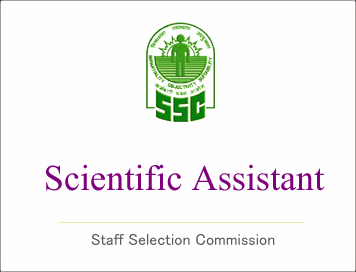
(Syllabus) SCIENTIFIC ASSISTANT EXAM
SYLLABUS
The details of the syllabus are given below.
Part-I
The Syllabus for General Intelligence would include questions of both verbal and non-verbal type. The test may include questions on analogies, similarities, differences, space visualization, problem solving, analysis, judgement, decision making, visual memory, discrimination, observation, relationship concepts, arithmetical reasoning, verbal and figure classification, arithmetical number series etc. The test will also include questions designed to test the candidate‟s abilities to deal with abstract ideas and symbols and their relationships, arithmetical computations and other analytical functions.
The questions will be designed to test the ability of appropriate use of numbers and number sense of the candidate. The scope of the test will be computation of whole numbers, decimals, fractions and relationships between numbers, Percentage, Ratio & Proportion, Square roots, Averages, interest, Profit and Loss, Discount, Partnership Business, Mixture and Alligation, Time and Distance, Time & Work, Basic algebraic identities of School Algebra & Elementary Surds, Graphs of Linear Equations, Triangle and its various Kinds of centers, Congruence and similarity of triangles, Circle and its chords, tangents, angles subtended by chords of a circle, common tangents to two or more circles, Triangle, Quadrilaterals, Regular Polygons, Circle, Right Prism, Right Circular Cone, Right Circular Cylinder, Sphere, Hemispheres, Rectangular Parallelepiped, Regular Right Pyramid with triangular or square base, Trigonometric ratio, Degree and Radian Measures, Standard Identities, Complementary angle, Heights and Distances, Histogram, Frequency polygon,
Bar diagram & Pie chart.
English grammar, Vocabulary, Spellings, Synonyms and Antonyms, Comprehension, Correct and incorrect usages, etc. (iv) General Awareness: General, physical, geographical, topographical, economic and climatic features of India. Current events. Matters of everyday observation and experience on scientific aspects and reasoning. Basic topics of mathematics, Chemistry and Physics. History
of India, its cultural heritage, freedom movement, salient feature of the Constitution of India.
Economic and social aspect of the country and its people.
Part-II
a) Physics
Mechanics: Units and dimensions, SI Units, Newton‟s Laws of Motion, conservation of linear and angular momentum, projectiles, rotational motion, moment of inertia, rolling motion, Newton‟s Law of gravitation, Planetary motion, Kepler‟s Laws of Planetary motion, artificial satellites, Fluid motion, Bernoulli‟s theorem, Surface tension, Viscosity, Elastic Constants, bending of beams, torsion of cylindrical bodies, elementary ideas of special theory of relativity.
Thermal Physics, Radiation & Sound: Thermometry, Zeroth, first and second laws of thermodynamics, reversible and irreversible processes, Internal energy, Heat engines, Maxwell‟s relation, ideal and real gases, equations of state, Heat Capacities, Adiabatic and Isothermal processes, Clausius-Clapeyron relation, Thermal Conductivity, Entropy, Enthalpy, Dalton‟s law of partial pressure, Vapour pressure, Kinetic theory of gases, Brownian motion, Maxwell‟s velocity distribution, Equipartition of energy, mean free path Vander walls‟ equation of State, Liquefaction of gases. Blackbody radiation, Kirchhoff‟s law, Stephen‟s law, Planck‟s law. Conduction in solids.
Wave and Oscillations: Simple harmonic motion, wave motion, superposition principle, Damped oscillations; forced oscillations and resonance; simple oscillatory systems; vibrations of rods, strings and air columns. Doppler effect; Ultrasonic; Sabine‟s law of reverberation; Recording and reproduction of sound.
Optics: Nature and propagation of light; Reflection & Refraction. Interference; diffraction; polarization of light; simple interferometers. Determination of wavelength of spectral lines, Electromagnetic spectrum. Rayleigh scattering, Raman effect, Lenses and mirrors, combination of coaxial thin lenses, spherical and chromatic aberrations, and their corrections, Microscope, Telescope, Eyepieces and Photometry.
Electricity and magnetism: Electric charges, fields and potentials, Gauss‟s theorem, Electrometers, Dielectrics, Magnetic properties of matter and their measurement, Elementary theory of dia, para and ferro-magnetism, Hysteresis, Electric current and their properties, Ohm‟s law, Galvanometers, Whetstone‟s bridge and applications, Potentiometers, Faraday‟s law of E.M. induction, self and mutual inductance and their applications, alternating currents, impedance and resonance, LCR circuit, Dynamos, motors, transformers, Peltier-Seebeck and Thomson effects and applications, electrolysis, Hall effect, Hertz experiment and
electro-magnetic waves, Particle accelerators and cyclotron.
Atomic structure: Electron, measurement of "e" and "e/m", measurement of Planck Constant, Rutherford-Bohr Atom, X-rays, Bragg‟s law, Moseley‟s law,
Radioactivity, Alpha-Beta-Gamma emission, Elementary ideas of nuclear structures, Fission, Fusion and Reactors, Louis de Broglie waves and Electron Microscope.
Electronics; Thermo-ionic emission, diodes and triodes, p-n diodes and transistors, simple rectifier, amplifier and oscillator circuits.
b) Computer Science and Information Technology
Computer: History of Computer and their classification, Basic Organization, Memory – RAM, ROM, EPROM, etc, Magnetic-Floppy, Hard disks, CDROM, WORM etc, Concept of Virtual Memory and Cache Memory, Number systems, binary octal, Hexadecimal, Binary Addition, Subtraction and Multiplication, Flotation, point representation and arithmetic, Arithmetic through stacks.
Operating systems: assemblers, elements of Assembly language programming Overview of the Assembly process, assembler for the IBM PC, Process synchronization, Memory Management – address Binding – dynamic Loading and linking – overlays – logical and Physical address space – Contiguous Allocation - internal& External Fragmentation. Non-Contiguous Allocation: Paging and
Segmentation Schemes – Implementation – Hardware Protection – Protection – sharing – Fragmentation.
Virtual Memory: Demand Paging – Page Replacement – Page Replacement algorithms – Thrashing.
File System: File Concepts – Assess Methods – Directory Structures – Protection Consistency Semantics – File system Structures – Allocation Methods – Free Space Management.
I/O System: Overview – I/O hardware – Application I/O Interface – Kernel I/O subsystem, Performance, Secondary Storage Structures, Protection, Goals,
Domain – Access matrix.
Assemblers: Elements of assembly language programming – Overview of the Assembly process – Design of a low-pass Assembler – a single pass Assembler forthe IBM PC. The security Problem – Authentication – Threats – Threat Monitoring – Encryption.
Fundamentals of programming: Unix Programming, Programming in FORTRAN, C, Object Oriented Programming in C++, programming in Java, Basics of compilers.
Database Management Systems: Advantages and components of a Database Management Systems, Data Types, Data Dictionary, Query Basics, Forms and Reports, Graphical objects, Error Handing, Distributing Application, Data Storage Methods, Data Clustering and Partitioning, Database Administration, Backup and Recovery, Security and Privacy, Distributed Databases, Client/Server Databases, Object Oriented Databases, Integrated Applications, SQL, RDBMS.
Internet Technology: Basics, topologies, layers, switching in the networks, bridges, routers and gateways, types of networks, WWW. Client/Server Applications, Internet Standards and specifications, ISP, Broad Band
Technologies, Protocols, web-servers, browsers, and security, fire walls, date security, HTML, dHTML, XML, Web designing.
Fundamentals of Geographical Information System (GIS): GIS Data and Spatial Models, Topology ad Spatial Operations, Projections, Scale and Coordinate Systems, Mapping, GIS Analysis, Cartography. Basics of GIS application development.
c) Electronics & Telecommunication
i) Electronics: Conductors, Semi-conductors, Insulators, Magnetic, Passive components, characteristics of Resistors, Capacitors and inductors.PN Junction diode, forward and reverse bias characteristics and equivalent circuits of diode, Zener diode and applications, clipping, clamping and rectifier circuits using diodes. Bipolar Junction Transistors (BJT) Field Effect Transistor (FET) and MOSFET; Biasing and stability, Emitter follower and its applications – Negatives feed backTransistor as a switch, Multistage Amplifiers, Feedback, Oscillators, Multivibrators, Voltage regulation, Power amplifiers. Introduction to Network Theorems: Kirchoff‟s laws, superposition, Thevenin‟s Norton‟s and Maximum power theorems. Voltage and Current relationship in the resistance, inductance and capacitance. Concept of reactance, susceptance, conductance, impedance and admittance in
series and parallel RL, RC and RLC circuits – Three phase supply-star and delta connection diagrams – Relation between line and phase & voltages and currents, series and parallel resonance circuits – condition of resonance, resonant frequency, Q factor and bandwidth.
Digital electronics: – Logic gates, Demorgan‟s theorem, Boolean algebra, frequency counters, flip-flops, shift resistors, Basic concepts of Digital to Analog and Analog to Digital Converters, Timing circuits, Digital logic circuits, systems & codes Combinational logic design.
ii) Telecommunication: Basic antenna principle directive gain, directivity, radiation pattern, broad-side and end-fire array, Yagi antenna, Parabolic antenna, Ground wave propagation, space waves, ionosphere propagation and electromagnetic frequency spectrum, Modulation, types of modulation, Amplitude Modulation (AM), Modulation index, Power relation in AM, Generation and Demodulation of AM.
Single Side Band (SSB): Power requirement in comparison with AM, Advantages of SSB over AM. Concept of Balanced Modulator, Generation of SSB, Pilot Carrier System. Independent Side System, Vestigial Sideband Transmission.
Frequency Modulation (FM): Definition of FM, Bandwidth, Noise triangle, Preemphasis and De-emphasis.
Pulse Modulation (PM): Definition of PM. Difference between AM and FM.
Radio receivers. Sampling Theorem, PAM, PTM, PWM, PPM, pulse code modulation, Quantization noise, commanding, PCM system, differential PCM, Delta modulation.
Multiplexing: FDM/TDM.
Introduction of digital Communication: PSK, ASK, FSK, introduction to fiber optics system, Propagation of light in optical fiber and ray model. Propagation of signals at HF, VHF, UHF and microwave frequency and satellite communications.
Courtesy : SSC
Companies / Organisations:
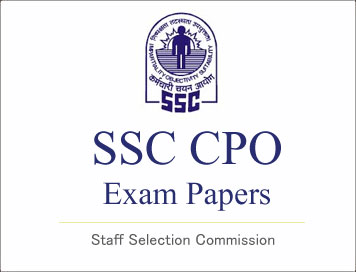
SSC CPO Exam Paper - 2017 "held on 01 July 2017" Shift-2
(English Comprehension)
351 - In the following question, some part of the sentence may have
errors. Find out which part of the sentence has an error and select the
appropriate option. If a sentence is free from error, select 'No Error'. Madhuri
and I have done my (1)/ work patiently and diligently (2)/ just for our safe and
secure future. (3)/ No Error (4)
Options:
1) 1
2) 2
3) 3
4) 4
Correct Answer: 1
352 - In the following question, some part of the sentence may have
errors. Find out which part of the sentence has an error and select the
appropriate option. If a sentence is free from error, select 'No Error'. Sunita
is feeling little uncomfortable today (1)/ because she is ill, so she can
perform (2)/ her work after having some rest for a while. (3)/ No Error (4)
Options:
1) 1
2) 2
3) 3
4) 4
Correct Answer: 2
353 - In the following question, some part of the sentence may have
errors. Find out which part of the sentence has an error and select the
appropriate option. If a sentence is free from error, select 'No Error'. We must
(1)/ denounce justice (2)/ and oppression. (3)/ No Error (4)
Options:
1) 1
2) 2
3) 3
4) 4
Correct Answer: 2
354 - In the following question, some part of the sentence may have
errors. Find out which part of the sentence has an error and select the
appropriate option. If a sentence is free from error, select ‘No Error’. I don’t
think, Neha is a wiser as (1)/ Sonali, so she is not (2)/ competent for this
job. (3)/ No Error (4)
Options:
1) 1
2) 2
3) 3
4) 4
Correct Answer: 1
355 - In the following question, some part of the sentence may have
errors. Find out which part of the sentence has an error and select the
appropriate option. If a sentence is free from error, select 'No Error'. In the
Mathematics class, I sit next to (1)/ Raj, who is the captain of the basket ball
(2)/ team and undoubtedly the best basket ball player in Delhi. (3)/ No Error
(4)
Options:
1) 1
2) 2
3) 3
4) 4
Correct Answer: 4
356 - In the following question, the sentence given with blank to be
filled in with an appropriate word. Select the correct alternative out of the
four and indicate it by selecting the appropriate option.
The examination will commence _____ next week.
Options:
1) since
2) from
3) on
4) with
Correct Answer: from
357 - In the following question, the sentence given with blank to be
filled in with an appropriate word. Select the correct alternative out of the
four and indicate it by selecting the appropriate option.
Sunita said that she had never _____ a book she liked so much.
Options:
1) viewed on
2) come across
3) held upon
4) saw into
Correct Answer: come across
358 - In the following question, the sentence given with blank to be
filled in with an appropriate word. Select the correct alternative out of the
four and indicate it by selecting the appropriate option.
Everything hinges _____ what happens next.
Options:
1) of
2) with
3) in
4) upon
Correct Answer: upon
359 - In the following question, the sentence given with blank to be
filled in with an appropriate word. Select the correct alternative out of the
four and indicate it by selecting the appropriate option.
Her father died because they did not immediately _____ a doctor.
Options:
1) call for
2) call up
3) call at
4) call in
Correct Answer: call up
360 - In the following question, the sentence given with blank to be
filled in with an appropriate word. Select the correct alternative out of the
four and indicate it by selecting the appropriate option.
Although his brother is blind, he is very fast _____ calculations.
Options:
1) in
2) with
3) at
4) about
Correct Answer: at
361 - In the following question, out of the four alternatives, select the
word similar in meaning to the word given.
Perfidious
Options:
1) vigour
2) disloyal
3) bondage
4) relinquish
Correct Answer: disloyal
362 - In the following question, out of the four alternatives, select the
word similar in meaning to the word given.
Apparition
Options:
1) award
2) correct
3) spirit
4) revenge
Correct Answer: spirit
363 - In the following question, out of the four alternatives, select the
word similar in meaning to the word given.
Insolent
Options:
1) bold
2) dirty
3) feud
4) lucid
Correct Answer: bold
364 - In the following question, out of the four alternatives, select the
word similar in meaning to the word given.
Sordid
Options:
1) unpleasant
2) variant
3) rigidity
4) tender
Correct Answer: unpleasant
365 - In the following question, out of the four alternatives, select the
word similar in meaning to the word given.
Tenuous
Options:
1) wry
2) linger
3) clean
4) thin
Correct Answer: thin
366 - In the following question, out of the four alternatives, select the
word opposite in meaning to the word given.
Babel
Options:
1) handsome
2) quiet
3) ignorant
4) careless
Correct Answer: quiet ]
367 - In the following question, out of the four alternatives, select the
word opposite in meaning to the word given.
Derisive
Options:
1) lenient
2) respectful
3) extravagant
4) hostile
Correct Answer: respectful
368 - In the following question, out of the four alternatives, select the
word opposite in meaning to the word given.
Reckless
Options:
1) puzzling
2) preacher
3) spiritual
4) cautious
Correct Answer: cautious
369 - In the following question, out of the four alternatives, select the
word opposite in meaning to the word given.
Arcane
Options:
1) public
2) dark
3) evasive
4) secret
Correct Answer: public
370 - In the following question, out of the four alternatives, select the
word opposite in meaning to the word given.
Wreck
Options:
1) advance
2) surfeit
3) triumph
4) build
Correct Answer: build
371 - In the following question, out of the four alternatives, select the
alternative which best expresses the meaning of the idiom/phrase.
Swelled head
Options:
1) Tired
2) Timid
3) Dreamer
4) Pride
Correct Answer: Pride
372 - In the following question, out of the four alternatives, select the
alternative which best expresses the meaning of the idiom/phrase.
To sow the dragon's teeth
Options:
1) To disturb the work
2) To suspect something foul
3) To take some action
4) To act foolishly
Correct Answer: To take some action
373 - In the following question, out of the four alternatives, select the
alternative which best expresses the meaning of the idiom/phrase.
Get around
Options:
1) Persuade
2) Recall
3) Exclude
4) Avoid
Correct Answer: Avoid
374 - In the following question, out of the four alternatives, select the
alternative which best expresses the meaning of the idiom/phrase.
To cudgel one's brains
Options:
1) To think hard
2) To kill by shooting in the head
3) To manipulate
4) To oppose someone
Correct Answer: To think hard
375 - In the following question, out of the four alternatives, select the
alternative which best expresses the meaning of the idiom/phrase.
Broke Priscian's head
Options:
1) To use bad grammar
2) To quarrel
3) To hurt with grief
4) To put an end to
Correct Answer: To use bad grammar
376 - Improve the bracketed part of the sentence.
(No sooner I saw) the lizard than I ran away.
Options:
1) As soon as I saw
2) No sooner I had seen
3) No sooner did I see
4) no improvement
Correct Answer: No sooner did I see
377 - Improve the bracketed part of the sentence.
Rohit (did many mischiefs).
Options:
1) committed many mischiefs
2) made many a mischiefs
3) made much mischiefs
4) no improvement
Correct Answer: committed many mischiefs
378 - Improve the bracketed part of the sentence.
The police (broke away)the concert as it turned violent.
Options:
1) broke through
2) broke up
3) broke off
4) no improvement
Correct Answer: broke up
379 - Improve the bracketed part of the sentence.
Reena cannot (put forth)with her nasty fellow.
Options:
1) put in
2) put out
3) put up
4) no improvement
Correct Answer: put up
380 - Improve the bracketed part of the sentence.
The kid jumped with delight on seeing the (joker) at the circus.
Options:
1) dud
2) ruffian
3) clown
4) no improvement
Correct Answer: clown
381 - In the following question, out of the four alternatives, select the
alternative which is the best substitute of the phrase.
To move along with quick, short twistings
Options:
1) limp
2) stroll
3) wriggle
4) stride
Correct Answer: wriggle
382 - In the following question, out of the four alternatives, select the
alternative which is the best substitute of the phrase.
Put off for a future time
Options:
1) codify
2) reticent
3) procrastinate
4) retaliate
Correct Answer: procrastinate
383 - In the following question, out of the four alternatives, select the
alternative which is the best substitute of the phrase.
Greedy for money
Options:
1) agnostic
2) rapacious
3) oblation
4) celibacy
Correct Answer: rapacious
384 - In the following question, out of the four alternatives, select the
alternative which is the best substitute of the phrase.
Speak in a very low tone
Options:
1) whisper
2) murmur
3) bass
4) baritone
Correct Answer: whisper
385 - In the following question, out of the four alternatives, select the
alternative which is the best substitute of the phrase.
Search for something
Options:
1) chum
2) hurl
3) solemnize
4) quest
Correct Answer: quest
386 - In the following question, four words are given out of which one
word is incorrectly spelt. Select the incorrectly spelt word.
Options:
1) appreciation
2) appropriate
3) apearance
4) assassination
Correct Answer: apearance
387 - In the following question, four words are given out of which one
word is incorrectly spelt. Select the incorrectly spelt word.
Options:
1) coalition
2) cofficient
3) classification
4) christmas
Correct Answer: cofficient
388 - In the following question, four words are given out of which one
word is incorrectly spelt. Select the incorrectly spelt word.
Options:
1) convenience
2) customary
3) coveteus
4) counselor
Correct Answer: coveteus
389 - In the following question, four words are given out of which one
word is incorrectly spelt. Select the incorrectly spelt word.
Options:
1) leneint
2) leisure
3) liquefier
4) lieutenant
Correct Answer: leneint
390 - In the following question, four words are given out of which one
word is incorrectly spelt. Select the incorrectly spelt word.
Options:
1) subsequence
2) secretariate
3) superstitious
4) superintendent
Correct Answer: secretariate
391 - In the following passage some of the words have been left out. Read
the passage carefully and select the correct answer for the given blank out of
the four alternatives.
One's mental attitude plays a very _____ role in one's life and _____.
One's attitude must be healthy, active and reasonably _____. One must begin the
day with a happy, energetic and _____ resolution with a firm _____ in God's
moral order and divine justice. This attitude will change the entire complexion
of life and make one more active, assertive and successful.
One's mental attitude plays a very _____ role
Options:
1) negligible
2) disgusting
3) important
4) mere
Correct Answer: important
392 - In the following passage some of the words have been left out. Read
the passage carefully and select the correct answer for the given blank out of
the four alternatives.
One's mental attitude plays a very _____ role in one's life and _____.
One's attitude must be healthy, active and reasonably _____. One must begin the
day with a happy, energetic and _____ resolution with a firm _____ in God's
moral order and divine justice. This attitude will change the entire complexion
of life and make one more active, assertive and successful.
in one's life and _____.
Options:
1) others
2) dreams
3) attitude
4) career
Correct Answer: career
393 - In the following passage some of the words have been left out. Read
the passage carefully and select the correct answer for the given blank out of
the four alternatives.
One's mental attitude plays a very _____ role in one's life and _____.
One's attitude must be healthy, active and reasonably _____. One must begin the
day with a happy, energetic and _____ resolution with a firm _____ in God's
moral order and divine justice. This attitude will change the entire complexion
of life and make one more active, assertive and successful.
One's attitude must be healthy, active and reasonably _____.
Options:
1) optimistic
2) pessimistic
3) balanced
4) challenging
Correct Answer: optimistic
394 - In the following passage some of the words have been left out. Read
the passage carefully and select the correct answer for the given blank out of
the four alternatives.
One's mental attitude plays a very _____ role in one's life and _____.
One's attitude must be healthy, active and reasonably _____. One must begin the
day with a happy, energetic and _____ resolution with a firm _____ in God's
moral order and divine justice. This attitude will change the entire complexion
of life and make one more active, assertive and successful.
day with a happy, energetic and _____ resolution
Options:
1) mere
2) large
3) hopeful
4) significant
Correct Answer: hopeful
395 - In the following passage some of the words have been left out. Read
the passage carefully and select the correct answer for the given blank out of
the four alternatives.
One's mental attitude plays a very _____ role in one's life and _____.
One's attitude must be healthy, active and reasonably _____. One must begin the
day with a happy, energetic and _____ resolution with a firm _____ in God's
moral order and divine justice. This attitude will change the entire complexion
of life and make one more active, assertive and successful.
with a firm _____ in God's moral order and divine justice.
Options:
1) resolution
2) decision
3) faith
4) idea
Correct Answer: faith
396 - A passage is given with five questions following it. Read the
passage carefully and select the best answer to each question out of the given
four alternatives.
The Ganges is one of the largest rivers in Asia. It rises in the Himalaya
Mountains and flows over 2,500 km through India and Bangladesh into the Bay of
Bengal. However, the Ganges, India's holy river, is also one of the most
polluted in the world. The Ganges River basin has a size of over 1 million
square km. It lies in one of the most populous regions on earth. About 500
million people, half of India's overall population, live in the Ganges river
plains.
There are many causes of Ganges river pollution. About 2 million Hindus bathe
in the river every day. During religious ceremonies, up to a hundred million
people clean their sins away in the Ganges River. They believe that bathing in
the river will make them pure. In addition, thousands of bodies are cremated
near the river, especially around the holy city, Varanasi. The ashes are often
released into Ganges.
The Ganges also provides water for farming land, which is increasing at a
tremendous rate. Irrigation projects cause water levels to go down along the
river. More and more dams are being erected along India's holy river, mainly to
produce energy for Delhi and other large cities in the area.
The river flows through 30 cities with a population of over 100,000 each.
Every day, 3 billion litres of untreated water from these big cities pass into
the Ganges River, along with remains of animals.
Because of India's lax environmental regulations, industries along the river
release chemicals and other poisonous material into the Ganges. In some places
they are a thousand times over the allowed limit. Especially India's traditional
leather industry needs great amounts of water. In addition, fertilizers from the
fields find their way into the ground water, and ultimately flow into the river.
Altogether, the amount of industrial pollution has doubled in the past 20 years.
This widespread pollution of the Ganges River has also led to major health
problems. Many diseases are common, including cholera, hepatitis and diarrhea.
While India's population keeps growing, more and more people are leaving the
countryside and moving to big cities along the Ganges. As a result, the river
will not be able to cope with even more people.
Life in the river is also at risk. Recent reports have shown that there is a
high level of mercury in some fish. The construction of dams is destroying
forests and vegetation, killing off many animal and plants.
Indian authorities are fighting an upward battle towards cleaning up the Ganges
River. International organizations have offered help. The World Bank has agreed
to give India a loan of up to a billion dollars to clean up the Ganges River.
From which of the following neighbouring countries, The Ganga flow through
India into Bay of Bengal?
Options:
1) China
2) Bhutan
3) Bangladesh
4) Sri Lanka
Correct Answer: Bangladesh
397 - A passage is given with five questions following it. Read the
passage carefully and select the best answer to each question out of the given
four alternatives.
The Ganges is one of the largest rivers in Asia. It rises in the Himalaya
Mountains and flows over 2,500 km through India and Bangladesh into the Bay of
Bengal. However, the Ganges, India's holy river, is also one of the most
polluted in the world. The Ganges River basin has a size of over 1 million
square km. It lies in one of the most populous regions on earth. About 500
million people, half of India's overall population, live in the Ganges river
plains.
There are many causes of Ganges river pollution. About 2 million Hindus bathe
in the river every day. During religious ceremonies, up to a hundred million
people clean their sins away in the Ganges River. They believe that bathing in
the river will make them pure. In addition, thousands of bodies are cremated
near the river, especially around the holy city, Varanasi. The ashes are often
released into Ganges.
The Ganges also provides water for farming land, which is increasing at a
tremendous rate. Irrigation projects cause water levels to go down along the
river. More and more dams are being erected along India's holy river, mainly to
produce energy for Delhi and other large cities in the area.
The river flows through 30 cities with a population of over 100,000 each.
Every day, 3 billion litres of untreated water from these big cities pass into
the Ganges River, along with remains of animals.
Because of India's lax environmental regulations, industries along the river
release chemicals and other poisonous material into the Ganges. In some places
they are a thousand times over the allowed limit. Especially India's traditional
leather industry needs great amounts of water. In addition, fertilizers from the
fields find their way into the ground water, and ultimately flow into the river.
Altogether, the amount of industrial pollution has doubled in the past 20 years.
This widespread pollution of the Ganges River has also led to major health
problems. Many diseases are common, including cholera, hepatitis and diarrhea.
While India's population keeps growing, more and more people are leaving the
countryside and moving to big cities along the Ganges. As a result, the river
will not be able to cope with even more people.
Life in the river is also at risk. Recent reports have shown that there is a
high level of mercury in some fish. The construction of dams is destroying
forests and vegetation, killing off many animal and plants.
Indian authorities are fighting an upward battle towards cleaning up the Ganges
River. International organizations have offered help. The World Bank has agreed
to give India a loan of up to a billion dollars to clean up the Ganges River.
How many people (in million) clean their sins away in the Ganga River?
Options:
1) 2
2) 100
3) 500
4) 750
Correct Answer: 100
398 - A passage is given with five questions following it. Read the
passage carefully and select the best answer to each question out of the given
four alternatives.
The Ganges is one of the largest rivers in Asia. It rises in the Himalaya
Mountains and flows over 2,500 km through India and Bangladesh into the Bay of
Bengal. However, the Ganges, India's holy river, is also one of the most
polluted in the world. The Ganges River basin has a size of over 1 million
square km. It lies in one of the most populous regions on earth. About 500
million people, half of India's overall population, live in the Ganges river
plains.
There are many causes of Ganges river pollution. About 2 million Hindus bathe
in the river every day. During religious ceremonies, up to a hundred million
people clean their sins away in the Ganges River. They believe that bathing in
the river will make them pure. In addition, thousands of bodies are cremated
near the river, especially around the holy city, Varanasi. The ashes are often
released into Ganges.
The Ganges also provides water for farming land, which is increasing at a
tremendous rate. Irrigation projects cause water levels to go down along the
river. More and more dams are being erected along India's holy river, mainly to
produce energy for Delhi and other large cities in the area.
The river flows through 30 cities with a population of over 100,000 each. Every
day, 3 billion litres of untreated water from these big cities pass into the
Ganges River, along with remains of animals.
Because of India's lax environmental regulations, industries along the river
release chemicals and other poisonous material into the Ganges. In some places
they are a thousand times over the allowed limit. Especially India's traditional
leather industry needs great amounts of water. In addition, fertilizers from the
fields find their way into the ground water, and ultimately flow into the river.
Altogether, the amount of industrial pollution has doubled in the past 20 years.
This widespread pollution of the Ganges River has also led to major health
problems. Many diseases are common, including cholera, hepatitis and diarrhea.
While India's population keeps growing, more and more people are leaving the
countryside and moving to big cities along the Ganges. As a result, the river
will not be able to cope with even more people.
Life in the river is also at risk. Recent reports have shown that there is a
high level of mercury in some fish. The construction of dams is destroying
forests and vegetation, killing off many animal and plants.
Indian authorities are fighting an upward battle towards cleaning up the Ganges
River. International organizations have offered help. The World Bank has agreed
to give India a loan of up to a billion dollars to clean up the Ganges River.
According to the passage, which disease is not common due to the
widespread pollution of the Ganga River?
Options:
1) Influenza
2) Diarrhoea
3) Hepatitis
4) Cholera
Correct Answer: Influenza
399 - A passage is given with five questions following it. Read the
passage carefully and select the best answer to each question out of the given
four alternatives.
The Ganges is one of the largest rivers in Asia. It rises in the Himalaya
Mountains and flows over 2,500 km through India and Bangladesh into the Bay of
Bengal. However, the Ganges, India's holy river, is also one of the most
polluted in the world. The Ganges River basin has a size of over 1 million
square km. It lies in one of the most populous regions on earth. About 500
million people, half of India's overall population, live in the Ganges river
plains.
There are many causes of Ganges river pollution. About 2 million Hindus bathe in
the river every day. During religious ceremonies, up to a hundred million people
clean their sins away in the Ganges River. They believe that bathing in the
river will make them pure. In addition, thousands of bodies are cremated near
the river, especially around the holy city, Varanasi. The ashes are often
released into Ganges.
The Ganges also provides water for farming land, which is increasing at a
tremendous rate. Irrigation projects cause water levels to go down along the
river. More and more dams are being erected along India's holy river, mainly to
produce energy for Delhi and other large cities in the area.
The river flows through 30 cities with a population of over 100,000 each. Every
day, 3 billion litres of untreated water from these big cities pass into the
Ganges River, along with remains of animals.
Because of India's lax environmental regulations, industries along the river
release chemicals and other poisonous material into the Ganges. In some places
they are a thousand times over the allowed limit. Especially India's traditional
leather industry needs great amounts of water. In addition, fertilizers from the
fields find their way into the ground water, and ultimately flow into the river.
Altogether, the amount of industrial pollution has doubled in the past 20 years.
This widespread pollution of the Ganges River has also led to major health
problems. Many diseases are common, including cholera, hepatitis and diarrhea.
While India's population keeps growing, more and more people are leaving the
countryside and moving to big cities along the Ganges. As a result, the river
will not be able to cope with even more people.
Life in the river is also at risk. Recent reports have shown that there is a
high level of mercury in some fish. The construction of dams is destroying
forests and vegetation, killing off many animal and plants.
Indian authorities are fighting an upward battle towards cleaning up the Ganges
River. International organizations have offered help. The World Bank has agreed
to give India a loan of up to a billion dollars to clean up the Ganges River.
According to the passage, which industry in India needs great amount of
water?
Options:
1) lock
2) dyeing
3) cloth
4) leather
Correct Answer: leather
400 - A passage is given with five questions following it. Read the
passage carefully and select the best answer to each question out of the given
four alternatives.
The Ganges is one of the largest rivers in Asia. It rises in the Himalaya
Mountains and flows over 2,500 km through India and Bangladesh into the Bay of
Bengal. However, the Ganges, India's holy river, is also one of the most
polluted in the world. The Ganges River basin has a size of over 1 million
square km. It lies in one of the most populous regions on earth. About 500
million people, half of India's overall population, live in the Ganges river
plains.
There are many causes of Ganges river pollution. About 2 million Hindus bathe in
the river every day. During religious ceremonies, up to a hundred million people
clean their sins away in the Ganges River. They believe that bathing in the
river will make them pure. In addition, thousands of bodies are cremated near
the river, especially around the holy city, Varanasi. The ashes are often
released into Ganges.
The Ganges also provides water for farming land, which is increasing at a
tremendous rate. Irrigation projects cause water levels to go down along the
river. More and more dams are being erected along India's holy river, mainly to
produce energy for Delhi and other large cities in the area.
The river flows through 30 cities with a population of over 100,000 each. Every
day, 3 billion litres of untreated water from these big cities pass into the
Ganges River, along with remains of animals.
Because of India's lax environmental regulations, industries along the river
release chemicals and other poisonous material into the Ganges. In some places
they are a thousand times over the allowed limit. Especially India's traditional
leather industry needs great amounts of water. In addition, fertilizers from the
fields find their way into the ground water, and ultimately flow into the river.
Altogether, the amount of industrial pollution has doubled in the past 20 years.
This widespread pollution of the Ganges River has also led to major health
problems. Many diseases are common, including cholera, hepatitis and diarrhea.
While India's population keeps growing, more and more people are leaving the
countryside and moving to big cities along the Ganges. As a result, the river
will not be able to cope with even more people.
Life in the river is also at risk. Recent reports have shown that there is a
high level of mercury in some fish. The construction of dams is destroying
forests and vegetation, killing off many animal and plants.
Indian authorities are fighting an upward battle towards cleaning up the Ganges
River. International organizations have offered help. The World Bank has agreed
to give India a loan of up to a billion dollars to clean up the Ganges River.
Which International organization has agreed to give India a loan of a
billion dollar to clean up the Ganga River?
Options:
1) The World Bank
2) IMF
3) ADB
4) IDA
Correct Answer: The World Bank

SSC CPO Exam Paper - 2017 "held on 01 July 2017" Shift-2
(General Knowledge and General Awareness)
251 - In Indian economy, the sectors are divided into Private and Public
on what basis?
Options:
1) Ownership of enterprises
2) Usage of raw materials
3) Nature of economic activities
4) Employment policies
Correct Answer: Ownership of enterprises
252 - Which method is used to measure agricultural income in India?
Options:
1) Expenditure method
2) Output method
3) Commodity flow method
4) Input method
Correct Answer: Output method
253 - Who estimated the National Income in India for the first time?
Options:
1) Prof. P. C. Mahalanobis
2) Dr. V. K. R. V. Rao
3) Dadabhai Naoroji
4) M. G. Ranade
Correct Answer: Dadabhai Naoroji
254 - GDP – indirect taxes + subsidies = ______
Options:
1) NNP at factor cost
2) GDP at factor cost
3) GNP
4) Personal Income
Correct Answer: GDP at factor cost
255 - Establishment of Chittaranjan Locomotive took place during which
Five Year Plan?
Options:
1) Second
2) Third
3) Fourth
4) First
Correct Answer: First
256 - What is the meaning of 'Laissez Faire Policy'?
Options:
1) Fair legislation
2) Control over trade
3) Withdrawal of 'some restrictions'
4) None of these
Correct Answer: Withdrawal of 'some restrictions'
257 - Who is the head of Municipal Corporation?
Options:
1) Prime Minister
2) Sarpanch
3) Governor
4) Mayor
Correct Answer: Mayor
258 - Which form of government believes in giving equal rights and
opportunities for women and men?
Options:
1) Feminist
2) Secularist
3) Castiest
4) Communalist
Correct Answer: Feminist
259 - What is the maximum period for which the vice president can act as
the President in case of vacancy in the the president's office?
Options:
1) 3 months
2) 6 months
3) 1 year
4) 2 years
Correct Answer: 6 months
260 - Currently, how many languages are recognized by Indian Constitution?
Options:
1) Fourteen
2) Fifteen
3) Sixteen
4) Twenty-two
Correct Answer: Twenty-two
261 - Which among the following is not appointed by the President of
India?
Options:
1) Vice-President of India
2) Judge of Supreme Court
3) Attorney General of India
4) Chief Justice of India
Correct Answer: Vice-President of India
262 - Which of the following article describes India also as Bharat?
Options:
1) Article 1
2) Article 2
3) Article 3
4) Article 4
Correct Answer: Article 1
263 - Which of the following writ is issued by a higher court to a lower
court?
Options:
1) Habeas Corpus
2) Quo Warranto
3) Prohibition
4) None of these
Correct Answer: Prohibition
264 - 'The Loyal Muhammadans of India' was a newspaper by which of the
following?
Options:
1) Mohammad Ali Jinnah
2) Ashfaqulla Khan
3) Shaukat Ali
4) Sayyed Ahmed Khan
Correct Answer: Sayyed Ahmed Khan
265 - Who among of the following was the founder of society called 'Abhinav
Bharat'?
Options:
1) Lala Lajpat Rai
2) Bal Gangadhar Tilak
3) Vinayak Damodar Savarkar
4) Bipin Chandra Pal
Correct Answer: Vinayak Damodar Savarkar
266 - First battle of Panipat was fought between which two armies?
Options:
1) Babur and Lodi Empire
2) Britishers and Babur
3) Akbar and Hemu
4) Akbar and Rana of Mewar
Correct Answer: Babur and Lodi Empire
267 - Arrange the following historical events in the chronological order
of their occurrence.
I. Champaran Satyagraha
II. Partition of Bengal
III. Jallianwala Bagh Massacre
Options:
1) I, II, III
2) II, III, I
3) II, I, III
4) I, III, II
Correct Answer: II, I, III
268 - Which of the following civilization is famous for its city/town
planning?
Options:
1) Indus Valley Civilization
2) Mesopotamian Civilization
3) Persian Civilization
4) Egyptian Civilization
Correct Answer: Indus Valley Civilization
269 - Which of the following is suitable for well irrigation?
Options:
1) Rock surface of Peninsula
2) Dry surface/tracts of Rajasthan
3) Costal Plains
4) Deltaic region of Mahandi River
Correct Answer: Deltaic region of Mahandi River
270 - Rotational axis of which of the following planet is highly tilted?
Options:
1) Earth
2) Uranus
3) Neptune
4) Jupiter
Correct Answer: Uranus
271 - Near coastal areas, temperature on land in day time gets reduced due
to _____.
Options:
1) Land breeze
2) Sea breeze
3) Both land and sea breeze
4) Sparsely populated coasts
Correct Answer: Sea breeze
272 - Which of the following city is located on the banks of river
Potomac?
Options:
1) Berlin
2) Islamabad
3) Madrid
4) Washington D.C.
Correct Answer: Washington D.C.
273 - How much is the difference of time between any two consecutive
longitudes?
Options:
1) 10 minutes
2) 14 minutes
3) 4 minutes
4) 30 minutes
Correct Answer: 4 minutes
274 - Which of the following is considered as physical basis of life?
Options:
1) Cell wall
2) Cell membrane
3) Mitochondria
4) Protoplasm
Correct Answer: Protoplasm
275 - Who of the following is known as 'Father of Zoology'?
Options:
1) Darwin
2) Aristotle
3) Heckle
4) Edward Jenner
Correct Answer: Aristotle
276 - Which of the following branch of biology is related with study of
heredity and variations?
Options:
1) Microbiology
2) Immunology
3) Genetics
4) Entomology
Correct Answer: Genetics
277 - Which of the following is NOT a vestigial organ in human body?
Options:
1) Thymus Gland
2) Wisdom teeth
3) Pharynx
4) Thyroid gland
Correct Answer: Thyroid gland
278 - Bile is produced by which of the following gland?
Options:
1) Liver
2) Kidney
3) Gall bladder
4) Spleen
Correct Answer: Liver
279 - Which of the following cells secret insulin?
Options:
1) α cells
2) β cells
3) δ cells
4) Nerve cells
Correct Answer: β cells
280 - Mass of an object is a _____.
Options:
1) Physical Quantity
2) Fundamental Quantity
3) Scalar Quantity
4) All options are correct
Correct Answer: All options are correct
281 - When a bus starts suddenly, then passengers in the bus tend to fall
backwards. This event is an example of _____.
Options:
1) Inertia of rest
2) Inertia of motion
3) Inertia of direction
4) None of these
Correct Answer: Inertia of rest
282 - Momentum of an object depends on which factors?
I. Mass of the object
II. Speed of the object
III. Volume of the object
Options:
1) I only
2) I and II only
3) I and III only
4) I, II and III
Correct Answer: I and II only
283 - What is the approximate height of any geostationary satellite from
earth’s surface (in km)?
Options:
1) 36000
2) 45000
3) 48000
4) 30000
Correct Answer: 36000
284 - Which of the following is used to enter data and instructions into a
computer?
Options:
1) Software
2) Output device
3) Malware
4) Input device
Correct Answer: Input device
285 - Which among the following has largest storing space?
Options:
1) Giga byte
2) Mega byte
3) Tera byte
4) Kilo byte
Correct Answer: Tera byte
286 - Which among the following is a pure element?
Options:
1) Glass
2) Cement
3) Sodium
4) Steel
Correct Answer: Sodium
287 - Sodium bicarbonate is chemical name of which of the following?
Options:
1) Baking Soda
2) Washing Powder
3) Plaster
4) Fly-Ash
Correct Answer: Baking Soda
288 - How is atomic mass number determined?
Options:
1) By total number of protons
2) By total number of neutrons
3) By adding number of protons and neutrons
4) By total number of electrons
Correct Answer: By adding number of protons and neutrons
289 - Which of the following reaction is the main cause of energy radiated
from Sun?
Options:
1) Nuclear fission
2) Nuclear fusion
3) Chemical reaction
4) Diffusion reaction
Correct Answer: Nuclear fusion
290 - With which of the following is 'Van Mahotsav' associated?
Options:
1) Cutting of trees
2) Planting of trees
3) Genetic modification of trees
4) Increase in crops
Correct Answer: Planting of trees
291 - Plants which grow in salty water near sea shore are called as
______.
Options:
1) Halophytes
2) Xerophytes
3) Heliophytes
4) Saprophytes
Correct Answer: Halophytes
292 - How many ecological hotspots are present in India?
Options:
1) 2
2) 3
3) 4
4) 5
Correct Answer: 4
293 - The Union Ministry of Human Resource Development has launched a
nationwide 'Students for Soldiers: Vidya Veerta Abhiyan' to display portraits of
______ decorated soldiers in education institutes.
Options:
1) Ashok Chakra
2) Mahaveer Chakra
3) Paramveer Chakra
4) Veer Chakra
Correct Answer: Paramveer Chakra
294 - Who amongst the following gave the 'Periodic Law'?
Options:
1) Carlton McGee
2) Emil Fischer
3) Charles Darwin
4) Dmitri Mendeleev
Correct Answer: Dmitri Mendeleev
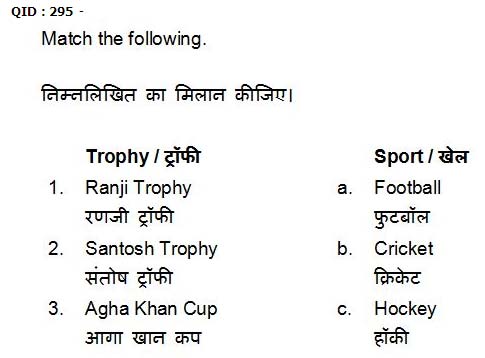
Options:
1) 1 – a, 2 – b, 3 – c
2) 1 – b, 2 – a, 3 – c
3) 1 – a, 2 – c, 3 – b
4) 1 – b, 2 – c, 3 – a
Correct Answer: 1 – b, 2 – a, 3 – c
296 - Which of the following pair is INCORRECT?
Options:
1) Ghoomar – Rajasthan
2) Bihu – Bihar
3) Bhangra – Punjab
4) Lavani – Maharashtra
Correct Answer: Bihu – Bihar
297 - In the 64th National Awards, which Hindi film has been awarded the
Best Hindi Film for the year 2016?
Options:
1) Neerja
2) Udta Punjab
3) Dangal
4) Sultan
Correct Answer: Neerja
298 - The book 'Hope in a challenged Democracy' is authored by _____.
Options:
1) M. Veerappa Moily
2) Sunita Narayan
3) Dr. Ashwini Kumar
4) Anuradha Roy
Correct Answer: Dr. Ashwini Kumar
299 - With which country India has signed a bilateral contract for
development and operations of Chabahar port?
Options:
1) Israel
2) Iran
3) Tehran
4) Turkey
Correct Answer: Iran
300 - 'Operation Pawan' was a peace-keeping operation by India in its
which neighbouring country?
Options:
1) Myanmar
2) Bangladesh
3) Nepal
4) Sri Lanka
Correct Answer: Sri Lanka
SSC Courses and Programs:

General Knowledge for SSC Exams (Ancient India)
The discovery of Mohenjodaro and Harappa by British
archaeologist: Marshall proved that Indian civilization is the oldest
civilization in the world. Even India came before Greece, considered the oldest
civilization before the discovery of Mohenjodaro and Harappa. The main features
of Ancient Indian History are as follows:
Indus Valley Civilization
Discovery : In 1921, R.B. Dayaram Sahani, first
discovered Harappa, in the Montgomery district of the Punjab. According to
radio-carbon dating, it spread from the year 2350-1750.
Dr. R. D. Banerjee found the ancient city Mohenjodaro
(literally, ‘city of the dead’) in Larkana district of Sindh, now in Pakistan in
1922.
The Marvelous Town Planning of Mohenjodaro: A chief feature
of Mohenjodaro is its superb town planning. The streets, which divided the city
into neat rectangular or square blocks, varied in width but always intersected
each other at right angles. The city had an elaborate drainage system,
consisting of horizontal and vertical drains, street drains and so on. The
architecture of the buildings was clearly intended to be functional and
minimalist, and certainly not to please the aesthete. Mohenjodaro was obviously
a cosmopolitan city, with people of different races mingling with the local
populace-Proto-Austroloid, Mediterranean, Alpine and Mongoloid.Before the coming
of Aryans, there was a civilization that was not only well-developed, but
actually far more sophisticated than that of the Aryans. The beginning and end
of the Indus Valley Civilization are both a matter of debate because people
could not have emerged complete with their perfect town planning, neat houses,
lovely jewellery and loads of make-up. So where did they come from? and then
having come, just where did they disappear? Popular theory, which is most
accepted is that the people of the Harappan civilization were chased out by the
Aryans and went down south. The present South Indians are their descendants.
The Vedic Period (1500 Bc-600 Bc)
Initially, Aryans settled in the area of Sapt-Sindhu, which
included Punjab, Kashmir, Sindh, Kabul and Gandhara (Kandhar). The chief sources
of this period are The Vedas and the Epics, the Mahabharata and the Ramayana,
which through their stories and hymns tell us about the expansion of the Aryans.
The epic Ramayana is a symbolic tale which tells of the Aryan expansion to the
south-the good, almost godly, aryaputra (an Aryan’s son) king Rama surging forth
to finish off the evil Dasyu (that was what the Aryans called the natives)
Ravana.
Aryans Political System
There was complex political system. They hung around together
in small village settlements (which later grew to kingdoms) and the basis of
their political and social organization was the clan or kula. It was very much a
patriarchal society, with the man the house expected to keep his clan in
control.
The King was the Supreme
Power
The king was the supreme power though he had to work in
tandem with the people’s wishes. He had an elaborate court of many officials,
including the chief queen (Mahishi) who was elected to help in the decision
making process. Two Assemblies, Sabha and Samiti further assisted the king.
No Rigidity in Caste System
The caste system was a loose social system where people could
move up and down the social scale. Aryan’s worshipped nature gods-they prayed to
the Usha (Dawn), Prajapati (The Creator), Rudra (Thunder), Indra (Rain), Surya
(Sun) and so on. These gods and goddesses were appeased by prayers and
sacrifices. The status of woman declined.
There are 6 school of Indian philosophy known as Shad-Darshans.
Darshana
|
Founder
|
| (1) Sankhya |
Kapila |
| (2) Yoga |
Patanjali |
| (3) Nyaya |
Gautama |
| (4) Vaishesika |
Kanada |
| (5) Mimanra |
Jaimini |
|
(6) Vedant/Uttara mimaura |
Badarayana |
The earliest reference to the 4 Ashramas - Brahmacharya,
Grihastha, Vanprastha and Sanyara in found in teh Jabala Upanishad.
Growth of Buddhism and Jainism
Buddhism and Jainism were instant hits with the populace and
became powerful clannish minorities while the bulk of the people remained with
Aryanism. Not for long, however. As the two new religions which had extremely
charismatic leaders and very zealous followers caught the people’s imagination,
the influence of both faiths spread enough for kings to profess and actively
promote them.
Buddhism
Buddhism founded by Gautam Budha or Siddhartha.
-
The Buddha also known is Sakyamuni or Tathagata.
-
Born in 563 BC on the Vaishakha Poornima day at
Lumbini (near Kapilavastu), in Nepal
-
His father Suddhodana was the Shakya/Sakya ruler
-
His mother (Mahamaya, of Kosala dynasty) died after
7 days of his birth, brought up by stepmother Gautami.
-
Married at the age of 10 to Yoshodhara. Enjoyed the
married life for 3 years and had a son named Rahul.
-
After seeing an old man, a sick man, a corpse and
an ascetic, he decided to become a wanderer.
-
Left his palace at the age of 29 in search of truth
(also called Mahabhinishkramana’ or the Cheat renunciation) and wandered for
6 years.
-
Attained ‘Enlightenment’ at Gaya in Magadha (Bihar)
under the Pipal tree.
-
Delivered the first sermon at Samath where his five
disciples had settled. His first Sermon is called ‘Dharmachakra Privartana’
or ‘Turning of the wheel of Law’.
-
Attained Mahaparinirvana at Kushinagar (identical
with village Kasia in Deoria district of UP), in 483 BC at the age of 80 In
the Malla republic.
Buddhist Councils
First Council : At Rajgriha, in 483 BC under the
Chairmanship of Mehakassaapa (king was Ajatshatru). Divided the teachings of
Buddha in to two Pitakas- Vinaya Pitaka and Sutta Pitaka.
Second Council : At Vaisahali, in 383 BC under
Sabakami (King was Kalarouka), followers divided into Sthavirmadins and
Mahasanghikas.
Third Council : At Pataliputra, in 250 BC under
Magaliputa Tissa (King was Ashoka) In this, the third part of the Tripitaka was
coded in the Pali language.
Fourth Council : At Kashmir (Kundalvan) in 72 AD under
Vasumitra (King was Kanishka, Vice-Chairman was ashwaghosha), divided Buddhism
into Mahayana and Hinayana sects.
Buddist Literature : In Pali language.
Vinaya Pitaka : Rules of discipline in the Buddhist
monasteries.
Sutta Pitaka : Largest, contains collection of
Buddha’s sermons.
Abhidhamma Pitaka : Explanation of the philosophical
principles of the Buddhist religion.
Buddhist architecture development in three forms.
(i) Stupa - relics at the Buddha or same prominent Buddhist marks are preserval.
(ii) Chaita - prayer Hall
(iii) Vihara - reridence
Jainism
-
There were 24 Tirthankaras (Prophets or Gurus), all
Kashtriyas. First was Rishabhnath (Emblem: Bull).
-
The 23rd Tirthankar Parashwanath (Emblem: Snake)
was the son of King Ashvasena of Banaras.
-
The 24th and last Tirthankar was Vardhman Mahavira
(Emblem: Lion). He was born in kundagram (Distt Muzaffarpur, Bihar) in 599
BC.
-
His father Siddhartha was the head of Jnatrika
Clan.
-
His mother was Trishla, sister of Lichchavi prince.
Chetak of Vaishali.
-
Mahavira was related to Bimbisara.
-
Married to Yashoda, had a daughter named
Priyadarsena, whose husband Jamali became his first disciple.
-
At the age of 30, after the death of his parents,
he became an ascetic.
-
In the 13th year of his asceticism (on the 10th of
Vaishakha), outside the town of Jrimbhikgrama, he attained supreme knowledge
(kaivalya).
-
From now on he was called Jaina or Jitendriya and
Mahavira, and his followers were named Jains. He also got the title of
Arihant, i.e., worthy.
-
At the age of 72, he attained death of Pava, near
Patna, in 527 Bc.
-
Mahavira preached almost the same message as
Parshvanath and added one more, Brahmcharya (celibacy) to it.
-
Five vows of Janism are
-
Ahimsa ( non-jury)
-
Satya (non-lying)
-
Asteya (non-stealing)
-
Aparigraha (non-possession)
-
Brahmacharya (chasty)
India was divided into sixteen states as ‘Mahajanapadas’
just before the rise at Buddhism in India. The 16 states are
1. Anga
2. Magadha
3. Kasi
4. Kosala
5. Vijji
6. Malla
7. Chedi
8. Vansal/Vatsa
9. Kuru
10. Panchala
11. Matsya
12. Suresena
13. Assaka
14. Avanti
15. Gandhara
16. Kamboja
Magadh Empire
Haryanka
The Kingdom at Magadha emerged to be most powerful. The first
important Magadha king, who emerges into the limelight was Bimbisara (544–491
BC) of the. He was an extremely polished diplomat and crafty statesman. While
the earlier rulers had brought Magadha out of clear and present danger, it was
Bimbisara, who consolidated and increased that power and really gave it the
identity of a kingdom. Bimbisara was a contemporary of the Buddha and met him
twice. When he met him the second time, in Rajgriha (which is an important
Buddhist pilgrimage today), Bimbisara converted to Buddhism. Bimbisara was
assassinated by his impatient son Ajatsatru. Ajatsatru continued his imperialist
policies. The most famous rivalry went on between him and the Lichchavi dynasty
that ruled Vaishali (in Bihar), which he eventually managed to conquer.
Ajatsatru was a colourful character and a man of sentiment. There are tales of
his passionate affair with the chief courtesan of Vaishali, called Amrapali.
During his reign, that Buddha attained parinirvana (nirvana from all births and
bonds). Ajatsatru insisted upon a part of his relics be buried in a stupa
(shrine) that he got erected in Rajgriha.
Ajatshtru was succeeded by his son Vdayin, he haid the
foundation of the city of patliputra.
Shishunaga Dynasty
The Shishunanga dynasty faded fast after Ajatsatru. The last
recorded ruler of the family was Kakavarna who was put to death by
Mahapadmananda, of the Nanda dynasty, which followed the Shishunagas.
The Nandas known for their airs of magnificence and immense wealth (which they
amassed by huge taxation). They were of lowborn sudra stock and hence had the
odds stacked against them right from the start. The Nandas, though very powerful
with a huge standing army and a grand court, were apparently a very vain lot.
The most famous of this dynasty was Dhanananda. He started his own downfall by
insulting a certain unsightly looking Brahmin, who unfortunately for Dhanananda,
turned out to have surprising vision, intellect and Machiavellian cunning.
Alexander Invasion (Great Invasion)
Alexander, the son of Phillip of Macedonia (Greece), invaded
India in 326 BC. His major battle was with Poras, the king of Punjab on the
banks of river Jhelum. Alexander emerged victorius. It was the result of
Alexander’s invasion that the link between India and the West was initiated.
Mauryan Dynasty (321 Bc-185 BC)
The dynasty that Chandragupta and Chanakya established in
Magadha together, was the first real dynasty of Indian history. There is no
certain theory about the lineage of Mauryas. One of the most prominent theory
was that he was actually the son of Dhanananda mistress called Mura, and hence
the name Maurya. Whatever might be the lineage of Chandragupta Maurya, Chanakya,
with him made a formidable team and stayed together till the end of
Chandragupta’s reign, when Chanakya lived to see the early half of his successor
Bindusara’s (298-273BC) reign too. There is sufficient evidence to prove that
elaborate planning and much intrigue went to shake the Nandas out of the Magadha
throne. Megasthenese was a Greek to the court at maurya by selecus Nikator.
Chandragupt occupied, magadhan throne in 321 B.C. with the help at ‘Chanakya’ (Kautilya),
(Vishnu Gupta).
He was a dynamic and brilliant diplomat. He started sending
and receiving missions to Egypt, Greece, Persia, Mesopotamia and various other
countries. Trade increased, the economy prospered and there was general
prosperity in the kingdom. He was succeeded by Ashoka the Great.
Ashoka the Great
Ashoka Piyadassi Maurya (269-232 BC) was perhaps Buddhism’s
most famous convert. He has caught the imagination of many as the cruel king who
suddenly, after one battle, saw the light and became an avowed non-violent
though he did put all his brothers to death to come to the throne, but then that
was no different from what any other aspiring king would have done, and no doubt
any of his brothers in similar circumstances would have done the same. It was
during Ashoka’s reign, for the first time, almost the entire regions of
present-day India were united under one central authority. Ashoka made Buddhism
the state religion. Ashoka propounded the philosophy of Dhamma, which was
something like correct moral code of conduct meets metaphysics. It has been
suggested that Ashoka abandoned all violence so thoroughly that he even
disbanded the army. Ashoka also sent Buddhist missionaries abroad to spread the
light; the most famous of these was sent to then Ceylon (Sri Lanka), under his
own son Mahindra and daughter Sanghamitra.
After Ashoka, a few Mauryan kings came but they could not
sustain the kingdom. Consequently, the Mauryans were succeeded by Pushyamitra
Sunga (184-149 BC)
The Post-maurya Period
In the post-Maurya period, three dynasties jostled, came and
went with astonishing speed on the Magadhan throne. The first among these were
the Sungas, under whom the country made certain progress. The Sunga rulers were
also quite successful in checking foreign invasions. Art and culture also
flourished considerably under the Sungas who were particularly known to be great
patrons of both. The Sungas were followed by the Kanvas, who were almost like a
blip in the scene of Indian history, lasting only 45 years in all, The other
important dynasty of this PostMauryan confusion was the Andhras or the
Satavahanas. According to traditional sources, they were apparently Dasyus (as
opposed to Aryans) from south India. Even in Ashoka’s time, this dynasty had
risen to quite a bit of prominence along the southwest regions. Though the
dynasty was founded by Simukha (235-213 BC), it had 30 kings in all.
One of the most famous rulers of this dynasty was Sri Satkarni (194-184 BC), who
had a kingdom covering almost all of south India, down to the andhra region and
around with his capital as the present Aurangabad. The next important dynasty to
step into the scene were the Kushanas, about whom not much is known. Though
there is controversy even over the date of accession of their most important
king Kanishka, he most probably ruled sometime in the first century AD. Kanishka
has been greatly associated with Buddhism and his reign made the religion
popular again. It was in his reign that Buddhism split into two sects, Hinayana
(the older simpler religion when Buddha was not considered God) and Mahayana
(the more ritualistic Buddhism, which worships the Buddha). The latter was the
state religion of the Kushanas, who were Indo-Greek by origin.
Gupta Dynasty
After the Kushanas, India saw political unity only under the
second great dynasty of ancient Indian history after the Mauryas, the Guptas.
The imperial Guptas were great conquerors, efficient administrators and renowned
patrons of the arts, science and culture. What’s more, they lasted for long;
they had at least six strong rulers. Their reign is called the Golden Age of
ancient Indian history. It is during this reign that the Hinduism was revived.
To revive the glory of the ‘old’ culture, which had been obscured by the
so-called foreign rulers, must have been a matter of pride for them. For example
the caste system came back with a vengeance but no longer as the flexible loose
social structure of the early Aryan days, but a strict code that later became
such a curse for India.
Great Rulers of Gupta Dynasty
The first Gupta king was Chandra Gupta (320-335 AD), though
not much is known about him. Next in line was Samudragupta (335-375 AD) who, by
all accounts, seemed to have been nothing short of a genius. He introduced the
concept of annexation. It meant that he retained the old kings as vassals to
keep the administration going. He was a skillful diplomat who had excellent
relations with not only foreign rulers but also his vassal-kings, surely a much
more difficult task to achieve, Due to his ingenious ideas of government,
Samudragupta could establish a really powerful empire. He was also a great
scholar and was especially fond of poetry and spiritual studies.
Samudragupta was followed by his elder son Ramagupta (375-380
AD), who was a blot on that proud family’s good name. Apparently he was having
immense trouble with the central Asian Saka invaders who refused to budge from
borders of the empire and threatened to come in. Ramagupta sued for peace, and
the Saka king agreed on one condition that his queen Dhruvadevi he surrendered
to him. Which was okay with Ramagupta, but not his younger samudragupta who,
disguised as the queen, entered the Saka camp and killed his brother and married
Dhruvadevi and succeeded the throne. He came to be called Chandragupta
Vikramaditya (380-413AD) and was an excellent ruler. Vikramaditya’s main
achievement was that he managed to quash the stronghold of the Saka might
(called the Saka Satraps) in India. Fa-Hien, the famous Chinese Buddhist
traveller-student came to India during his rule. The next kings of the dynasty
were Kumaragupta (413-AD) anupta (455—468 AD). They were considerably troubled
by foreign invasions, especially the latter who had to contend with the Huns.
The Huns, were defeated by Skandagupta. The period between 458—540 AD saw five
Gupta rulers and the slipping away of the reigns of a once-powerful kingdom away
from their hands. The Guptas were the last great dynasty to rule India till the
Delhi Sultanate came along much later and certainly they were the end of great
Aryan rulers.
Vardhana Dynasty
The final important ruler of Ancient Indian history was
Harsha Vardhana (606-646 AD), who ruled not from Magadha but Thanesar (in modern
Haryana area) of the Vardhana dynasty. He was a Buddhist and convened many
Buddhist assemblies. The second Chinese traveller to come to India, Huien Tsang,
arrived during his reign. The south presented a medley of dynasties around the
time of Harsha Vardhana. There were the Pandyas (in regions of Mudurai,
Travancore and Tinnevelly), the Chalukyas (in present Maharashtra region) and
Pallavas (in modem Tamil Nadu region), who had this terrific battle of supremacy
going constantly. Pulakesan H (610-642AD) was the ablest of the Chalukyan kings
and for a time managed to keep the Chalukyan flag flying above the others.
Other Dynasties
The Most Powerful Cholas
The most important dynasty to rise out of the southern India
was Cholas. Unlike other dynasties (the Chalukyas, the Pallavas, the Pandvas or
the Rashtrakutas), their origins are not traced from outside, but very much from
the south itself. The Deccan region was at this time in much turmoil.
The Cholas managed with sheer tenacity over a period of 300
years from 900-1100 AD. This period saw the final settling down and
consolidation of Tamil culture. In whatever spherewhether of social
institutions, religion, fine arts, music, dance, jewellery, the standards that
were set during this period came to be regarded as classical, and dominate, in a
modified form, much of the living patterns of south Indians even today. This
period also saw the spread of this culture overseas to Southeast Asia, regions
with whom the Cholas had strong political and economic relations.
The Cholas came to power in the middle of the 9th century AD.
The first ruler was Rajaraja Chola I (985-1014 AD) and his son and successor
Rajendra Chola (1014-1035AD). Both father and son put their heads down and
campaigned in almost every direction. The Cholas had an effective navy and
Rajaraja, with a view to control this trade route completely, led an attack to
the Maldive Islands too. Rajendra I, ruled together with father for two years
before going solo in 1014 AD. He aggressively continued his father’s imperialist
policies with the annexation of the region around modem Hyderabad, which was
controlled by the Chalukyas at that time. He also turned his attention
northwards where he reached right upto the Ganges valley, Orissa and west Bengal
areas. Rajendra Chola I was killed in 1052 AD, in battle against his old foes,
the Chalukyas.
Ascent of Rajput Power
The timed the fading away of Harsha Vardhana (606-646 AD) and
with it the Vardhana might and the rise of Islamic power in India was occupied
with the ascent of Rajput power. This, however, wap a very short-lived period,
mainly due to the in-fighting among the fiercely divided Rajputs. As can be
imagined, India under the Rajputs was not exactly what one could call a single
and completely unified unit. Delhi and Ajmer, under the Chauhans, were the most
powerful states of this period. However, the first Rajputs to hit Delhi were the
Tomaras. One of the earliest Tomara rulers to settle in Delhi. Their rule was
pretty, short-lived, though, and soon the Chauhan Rajputs under the generalship
of Prithviraj Chauhan seized control of Lal Kot-Quila Rai Pithora in the 12th
century. There were other states where Rajputs were gaining prominence. Like
Kanauj (in present Uttar Pradesh) where in this period ruled Jaichand, a Rathore
(another Rajput family) ruler, who was a bitter rival of Prithviraj Chauhan. In
Bundelkhand (in Madhya Pradesh), the Chandravansi (of the moon family) Chandelas
were ruling.
Malwa and Gujarat were under the Paramaras (the most
important ruler was king Bhoj) and Chaulukyas (who are supposed to descendants
of the Chalukyas) respectively. This was a very troubled time in Indian history.
There was no clear central authority in sight and each petty ruler was daring to
dream the mad dream of ruling all over the country-which at that point in time
meant basically the Gangetic plains and the Deccan.
This is the main reason why no ruler was able to hold Delhi long enough to
establish a kingdom here, and also the principle reason why the Arabs and Turks
did not exactly have to sweat to the bone to stamp their ority all over them.
MEDIEVAL INDIA
The Sultanate of Delhi (1206 Ad-1526 Ad)
Mohammad Ghori invaded India & laid the foundation of the
Muslim dominion in India. He may be considered the ‘found of Muslim rule’ in
India.
The Slave Dynasty (1206-90)
He was a Turkish slave by origin, he was powerhard by
Mohammad Ghori who later made him his Governer. After the death of Ghori, Aibak
founded the slave Dyanrty in 1206.
He caustructed ‘Ahai din ka Jopra’ at Ajmer. He also began
the construction of Qutub Minar. His successor Iltutmish (1211 to 1235 AD)
completed the construciton of Qutub Minar slave dynarty is also famous for
having given Indian its first woman ruler.
Rajia was succeeded by his brother Bahram Shah. Another
important rular of slave dynasty was Balbau who introduced ‘Sajda & Paibor’ as
the normal forms of salutation.
The Khilji Dynasty (1209-1320 AD)
Jalaludin Khilji founded the Khilji Dynarty. Another
important rules was Alaudin Khilji- Amir Khusrau was his favourite court poet.
The Tughlaq Dynasty (1320-1414 AD)
Important rules was:- Ghiyasuddin Tughlaq, Mohammad-bin-Tughlq,
Firoz Shah Tughalaq.
The Lodhi Dynasty (1451-1526 AD)
Bahlol Lodhi founded teh lodhi Dynasty. Sikandar Lodhi
shifted his capital from Dehli to Agra, a city founded by him. Ibrahim Lodhi was
the least king at teh Lodhi Dynasty.
The Mughal Dynasty
(1526 AD-1540 AD and 1555 AD-1857 AD)
The first Mughal who invaded Delhi Sultanate was Zahir-ud-din
Muhammad Babur (15261530 AD), who had the blood of the great central Asian
families of Chingez Khan from his mother’s side and that of Timur from his
father’s, had been hunting for a home to call his own since he was a teenager.
He had been driven out of Samarkand and forced to set up a kingdom elsewhere by
his cousins and uncles. Babur looked at Kabul in Afghanistan to start afresh. In
1526, he crossed over the Indus to reach Panipat, where he defeated Ibrahim Lodi
in one of the most significant battles of Indian history. Babur was -a military
general of formidable credentials and his troops would follow him everywhere,
and indeed did for thoroughly battle-scarred his tenure. The first person he
defeated was Rana Sanga, who was perhaps appalled at Babur’s obvious intentions
of getting comfortable and staying on in Delhi. After taking Mewar, Babur moved
on other battlefields, defeating many kingdoms with a speed which was
astonishing.
Babur was succeeded by his son Humayun in 1530 AD, and ruled
till 1556 AD, in between which there was a break of 16 years when Sher Shah Suri
(1540-1556), an Afghan noble, overthrew him. However, after a long struggle
Humayun was able to take back his kingdom when, his sister, Gulbadan Begum wrote
his biography “Humayunama”. Sher Shah Suri died. Not for long though, for
Humayun died the very same year by slipping from the staircase of his library.
Humayun was succeeded by his son Jalal-ud-din Muhammad Akbar
(1556-1605 AD), at the age of 14. In 1556 AD, 14-year-old Akbar led his first
army to battle in the famous old battlefield of Panipat which no doubt was a
sentimental moment for him because, like all Mughals, he was fiercely clannish.
The Second battle of Panipat was fought in between him and Hemu, the Prime
Minister of the Sultan of Bengal, who had set out against Akbar, the moment he
heard the news about Humayun’s death.
This battle was to decide the future of the young Mughal for
Hemu was a formidable antagonist. Akbar managed to decisively beat Hemu. What
helped him was that Hemu got a little carried away and arrived in battle on an
elephant, which made him a pretty much a sitting duck; Akbar shot him an arrow
right into the eye. As soon as this occurred Hemu’s army panicked and ran away,
and Hemu himself was killed by Akbar. If the first battle of Panipat signaled
the arrival of the Mughals, the second was of greater importance. Akbar fought
battles all over India, and at the end of it all had an empire that stretched
down to the present Karnataka in the south, touching right upto the Hindukush
range in the north, all of Rajasthan in the west and after taking in Kashmir and
Bihar going on to Bengal in the east. Akbar was not only a good military man but
he had a great head for diplomacy and statesmanship as well. He is famous for
his Rajput diplomacy, which included some strategic matrimonial alliances (an
idea he was the first to use), that turned the fiercely independent Rajputs from
his hitter enemies to staunch allies who were ready to lay down their lives for
him. He also made many reforms in administration and army management, and
started many innovations.In 1600 AD, Jahangir rebelled against Akbar when he was
away in the Deecan engaged in battle. In the confusion of events to follow, Abul
Fazl was killed, which made the great Mughal emperor lived with his son. In
October 1605, Akbar fell ill and Jahangir was crowned emperor by him when he was
on his death bed. Jahangir married Nur Jahan in 1611. Nur Jahan was the real
power behind Jahangir. She was a great queen, and a woman of amazing gifts. She
was quite a beauty and set many trends in designs of clothes, textiles and
jewellery. The attar (perfume) of roses was just one of this great lady’s
innovations. She was also a very capable and shrewd administrator. No detail,
however small, escaped the queen’s attention. Her ability to keep a cool head
was almost legendary and she amazed even battlehardy generals with her calm and
poise in the middle of crisis. She has been accused of nepotism and of giving
rise to a class of nobility which composed entirely of her kith and kin, but
that she was entirely in control is dear fns the fact that she rebuked even her
brother when she thought so fit. However, Nur Jahan was not without failings and
her biggest was ambition, not only for herself but for her child-a daughter from
earlier marriage.
Jahangir was succeeded by his son Shahjahan. The reign of
Shahjahan has been widely acclaimed as the golden period of the Mughal dynasty.
Except for one drought in 1630 in the areas of Deccan, Gujrat and Khandesh, the
kingdom was secure and free from poverty. The coffers of the state were brimming
with the right stuff. So it’s no wonder that Shahjahan was the greatest and most
assiduous builder of the Mughal dynasty. In 1639, he decided to shift his
capital to Delhi and construct a new city there on the banks of the Yamuna, near
Ferozabad.
It was to be called Shahjahanabad and the famously
spectacular peacock throne (the one that Nadir Shah took away) was transferred
from Agra to the Red Fort, the new -seat of the Mughal rulers, on April 8,1648.
His greatest and most memorable of achievements of course was the breathtaking
Taj Mahal, which he built in the memory of his wife Mumtaz Mahal, who died in
child birth. The end of Shahjahan’s reign did not live upto the beginning; it
saw one of the messiest battles of succession that Indian history ever
witnessed. In September 1657, Shahjahan fell ill and it was rumored that the
emperor was dead. This was enough to spark off intense intrigue in the court.
All the four claimants to Shahjahan’s throne were the children of the same
mother. in 1657, Dara Shikoh was 43, Shah Shuja 41, Aurangzeb 39 and Murad 33.
All of them were governors of various provinces: Dara was the governor of
Punjab, Murad of Gujrat, Aurangzeb of the Deeean and Shah Shuja of Bengal.
Aurangzeb was the ablest of Shahjahan’s sons and a clear favorite for the
throne. His credentials, both in battle and administration were legendary.
Aurangzeb beat the armies of Dara Shikoh, Murad along with the Mughal armies
twice in battle, and move towards Agra, where Shah Jahan was convalescing.
Aurangzeb ruled the single largest state ever in Mughal history. Aurangzeb’s
rise to the throne was ruthless. However, he was no more cruel than others of
his family. He succeeded not because he was crueller but because he was more
efficient and more skilled in the game of statecraft with its background of
dissimulation; and if it’s any consolation, he never shed unnecessary blood.
Once established he showed himself a firm and capable
administrator who retained his grip of power until his death at the age of 88.
He was an orthodox Sunni Muslim who thought himself a model Muslim ruler. In
this zealousness to promote the cause of Islam, Aurangzeb made many fatal
blunders and needless enemies. He alienated the Rajputs, whose valuable and
trusted loyalty had been so hard won by his predecessors, revolted against him.
Eventually he managed to make peace with them, but he could never be easy in his
mind about Rajputana again, a fact that hampered his Deeean conquest severely.
Then, he made bitter enemies in the Sikhs and the Marathas. Things came to such
a head that Guru Teg Bahadur, the 9th Guru of the Sikhs was at first tortured
and then executed by Aurangzeb for not accepting Islam; a martyrdom which is
mourned to this day by the Sikh community. The 10th Guru of the Sikhs, Guru
Govind Singh then raised an open banner of revolt against Aurangzeb. By the
death of Aurangzeb in Aurangabad in 1707, there ended the mighty period of
Mughal dynasty.
SSC Courses and Programs:

General Knowledge for SSC Exams (Sources of History)
The Indian History is perhaps the oldest in the world, and
the sources of Indian History are the verbal history, because our ancients never
did bother about putting things down on paper and archaeological evidences.
Based on the evidences available today, Indian History, like the history of
every ancient culture in the world, is broadly divided into four periods as
mentioned below:
Pre-History
From the big bang, the primeval swamp to the Indus Valley
civilization. Though Indus Valley civilization is included in pre-historical
period. However, technical evidences shows that Indus Valley civilization did
have a script, although it has not been decoded yet. So, it is generally
included in Ancient History nowadays.
Ancient History
It begins from the Indus Valley civilization (for which the
date is a matter of hot debate, but historians have agreed to disagree on 3000
BC) to just after the king Harsha Vardhana, which is around 700-800 BC.
Medieval History
It begins from 800 BC to mid-18th century AD.
Modern History
From mid-18th century to the independence of India, which is
on August 15, 1947. The history of Modern India is further sub-divided into two
major periods:
1. The British Period.
2. The Indian Freedom Struggle and Partition of India.
SSC Courses and Programs:

SSC CPO Exam Paper - 2017 "held on 01 July 2017" Shift - 2
(Reasoning)
201 - In the following question, select the related word from the given
alternatives.
Chicken : Hen : : ? : ?
Options:
1) Horse : Mare
2) Rabbit : Goose
3) Bull : Doe
4) Boar : Foal
Correct Answer: Horse : Mare
202 - In the following question, select the related word from the given
alternatives.
Mason : Plumb line : : ? : ?
Options:
1) Surgeon : Scalpel
2) Sculptor : Spade
3) Blacksmith : Forcep
4) Gardener : Saw
Correct Answer: Surgeon : Scalpel
203 - In the following question, select the related letters from the given
alternatives.
BKPG : DNRJ : : CMOG : ?
Options:
1) DOQI
2) EPQJ
3) EQPJ
4) EQJP
Correct Answer: EPQJ
204 - In the following question, select the related letters from the given
alternatives.
DHPQ : ZDLM : : SWIY : ?
Options:
1) OSEU
2) OSUE
3) OESU
4) OTDV
Correct Answer: OSEU
205 - In the following question, select the related number from the given
alternatives.
256 : 290 : : 961 : ?
Options:
1) 1011
2) 1017
3) 1025
4) 1023
Correct Answer: 1025
206 - In the following question, select the related number from the given
alternatives.
14 : 194 : : 16 : ?
Options:
1) 254
2) 256
3) 258
4) 260
Correct Answer: 254
207 - In the following question, select the odd word from the given
alternatives.
Options:
1) Farmer
2) Blacksmith
3) Cobbler
4) Helper
Correct Answer: Helper
208 - In the following question, select the odd word pair from the given
alternatives.
Options:
1) Mumbai : President's House
2) Delhi : Parliament
3) Nagpur : Centre Point
4) Hyderabad : Charminar
Correct Answer: Mumbai : President's House
209 - In the following question, select the odd letters from the given
alternatives.
Options:
1) AZ
2) MN
3) IS
4) GT
Correct Answer: IS
210 - In the following question, select the odd letters from the given
alternatives.
Options:
1) LNPR
2) HJLN
3) SUVX
4) BDFH
Correct Answer: SUVX
211 - In the following question, select the odd number pair from the given
alternatives.
Options:
1) 8
2) 27
3) 49
4) 216
Correct Answer: 49
212 - In the following question, select the odd number pair from the given
alternatives.
Options:
1) 123 – 321
2) 456 – 654
3) 789 – 978
4) 678 – 876
Correct Answer: 789 – 978
213 - Arrange the given words in the sequence in which they occur in the
dictionary.
1. Clone
2. Climate
3. Clutter
4. Create
5. Clapped
Options:
1) 52143
2) 51234
3) 52134
4) 53124
Correct Answer: 52134
214 - Arrange the given words in the sequence in which they occur in the
dictionary.
1. Lasted
2. Loop
3. Lake
4. Litter
5. Listed
Options:
1) 31542
2) 31254
3) 31245
4) 31452
Correct Answer: 31542
215 - A series is given with one term missing. Select the correct
alternative from the given ones that will complete the series.
B, D, H, N, ?
Options:
1) T
2) U
3) V
4) W
Correct Answer: V
216 - A series is given with one term missing. Select the correct
alternative from the given ones that will complete the series.
AAA, BCD, CEG, ?
Options:
1) DGI
2) DFI
3) DGJ
4) DJG
Correct Answer: DGJ
217 - In the following question, select the missing number from the given
series.
127, 63, 31, 15, 7, ?
Options:
1) 2
2) 3
3) 4
4) 5
Correct Answer: 3
218 - In the following question, select the missing number from the given
series.
2, 22, 198, 1386, ?
Options:
1) 2770
2) 3990
3) 6930
4) 9702
Correct Answer: 6930
219 - A is taller than B. C is taller than D, but shorter than E. B is
shorter than D and D is taller than A. Who is the tallest?
1) E
2) C
3) B
4) D
Correct Answer: E
220 - If 'A + B' means 'A is father of B', 'A – B' means 'A is mother of
B', 'A * B' means 'A is brother of B' and 'A % B' means 'A is sister of B', then
how is Q related to S in 'P + Q * R – S'?
Options:
1) Husband
2) Uncle
3) Brother
4) Father
Correct Answer: Uncle
221 - P is shorter than Q but taller than T. R is the tallest and S is
shorter than P but not the shortest. Who is second last in the descending order
of height?
Options:
1) P
2) Q
3) S
4) T
Correct Answer: S
222 - In the following question, select the word which cannot be formed
using the letters of the given word.
QUALIFICATION
Options:
1) LIAR
2) FIAT
3) LION
4) FICTION
Correct Answer: LIAR
223 - In the following question, select the word which cannot be formed
using the letters of the given word.
POSSESSION
Options:
1) SESSION
2) POSE
3) POISE
4) OBSESS
Correct Answer: OBSESS
224 - In a certain code language, "RANGE" is written as "FIQEW" and "ARAGE"
is written as "FIDVF". How is "PRANK" written in that code language?
Options:
1) MQEWV
2) LPDVU
3) UVDPL
4) VWEQM
Correct Answer: LPDVU
225 - In a certain code language, "HAUNTED" is written as "4013592" and
"RINGED" is written as "763892". How is "HINGE" written in that code language?
Options:
1) 36589
2) 57864
3) 40359
4) 46389
Correct Answer: 46389
226 - If "P" denotes "divided by", "R" denotes "added to", "S" denotes
"subtracted from" and "Q" denotes "multiplied by", then
48 P 4 R 3 Q 4 S 6 Q 4 = ?
Options:
1) 20
2) 1
3) 6
4) 0
Correct Answer: 0
227 - In the following question, correct the equation by interchanging two
numbers.
9 × 3 – 8 ÷ 2 + 7 = 26
Options:
1) 3 and 7
2) 9 and 2
3) 7 and 9
4) 3 and 8
Correct Answer: 7 and 9
228 - If 9 θ 11 α 2 = 40 and 13 θ 12 α 3 = 75, then 40 θ 41 α 5 = ?
Options:
1) 340
2) 365
3) 320
4) 405
Correct Answer: 405
229 - If 8 α 48, 12 α 120 and 15 α 195, then what is the value of 'A' in
19 α A?
Options:
1) 323
2) 347
3) 360
4) 312
Correct Answer: 323
230 -
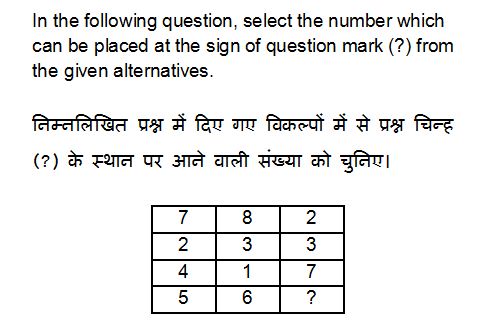
Options:
1) 1
2) 2
3) 4
4) 6
Correct Answer: 6
231.
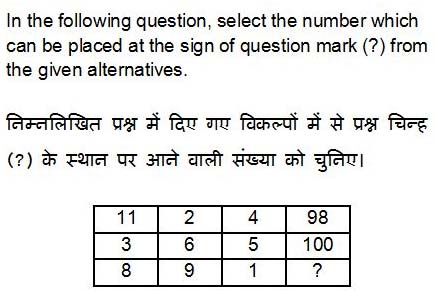
Options:
1) 72
2) 75
3) 88
4) 82
Correct Answer: 82
232.
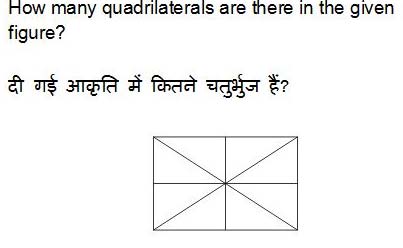
Options:
1) 13
2) 15
3) 17
4) 19
Correct Answer: 17
233.
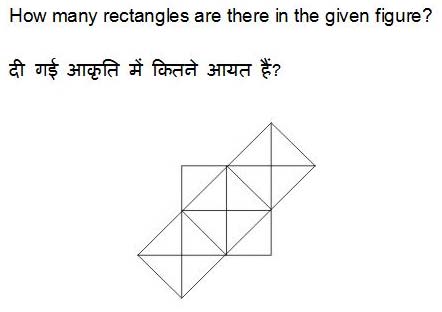
Options:
1) 15
2) 17
3) 19
4) 23
Correct Answer: 15
234 - In each of the following question below are given some statements
followed by some conclusions. Taking the given statements to be true even if
they seem to be at variance from commonly known facts, read all the conclusions
and then decide which of the given conclusion logically follows the given
statements.
Statements:
I. All pens are cups.
II. All glasses are cups.
Conclusions:
I. Some pens are glass.
II. Some glasses are cups.
III. Some glasses are pens.
Options:
1) Only conclusion (I) and (III) follow
2) Only conclusion (I) follows
3) Only conclusion (II) follows
4) No conclusion follows
Correct Answer: Only conclusion (II) follows
235 - In each of the following question below are given some statements
followed by some conclusions. Taking the given statements to be true even if
they seem to be at variance from commonly known facts, read all the conclusions
and then decide which of the given conclusion logically follows the given
statements.
Statements:
I. No pens are pencils.
II. No eraser is cup.
III. All pencils are erasers.
Conclusions:
I. Some pens are not erasers.
II. Some erasers are not pens.
III. No pencil is cup.
IV. Some erasers are cups.
Options:
1) Only conclusion (I) and (IV) follow
2) Only conclusion (I) and (III) follow
3) Only conclusion (II) and (III) follow
4) Only conclusion (II) and (IV) follow
Correct Answer: Only conclusion (II) and (III) follow
236.
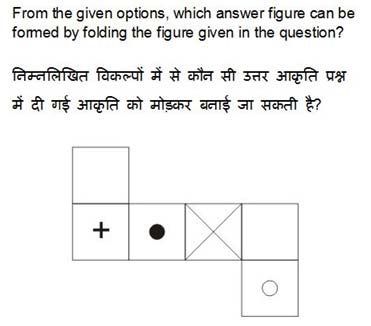
 237. 237.
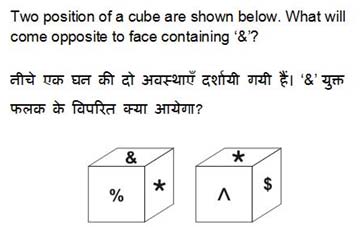
Options:
1) ^
2) %
3) $
4) None of these
Correct Answer: ^
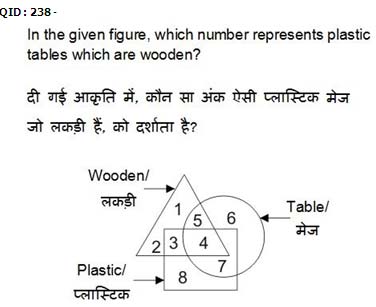
Options:
1) 3
2) 5
3) 7
4) 4
Correct Answer: 4
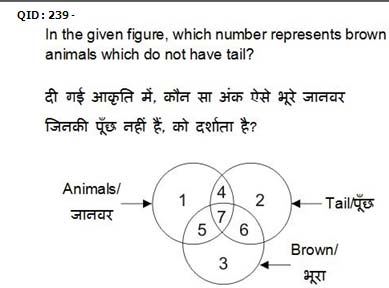
Options:
1) 7
2) 4
3) 5
4) 6
Correct Answer: 5
240.
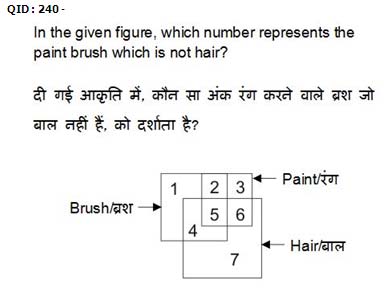
Options:
1) 4
2) 3
3) 5
4) 2
Correct Answer: 2
241.
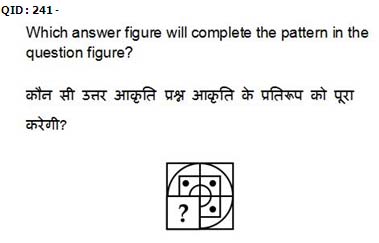

242.
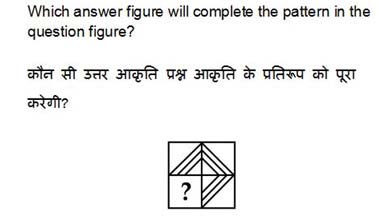

243.
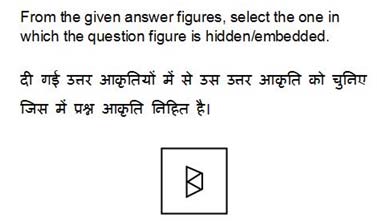

244.
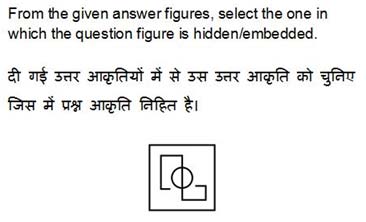

245.
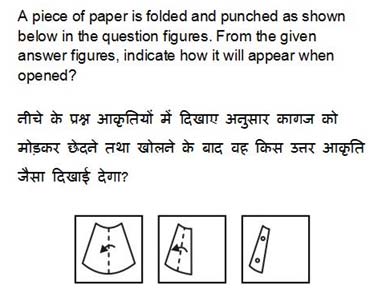

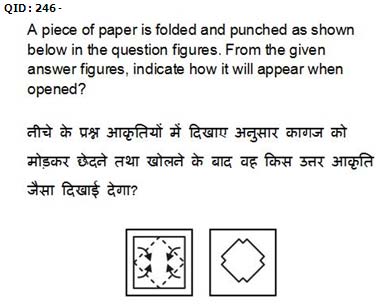

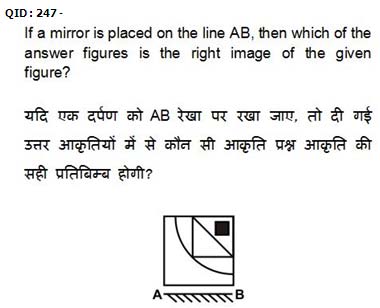

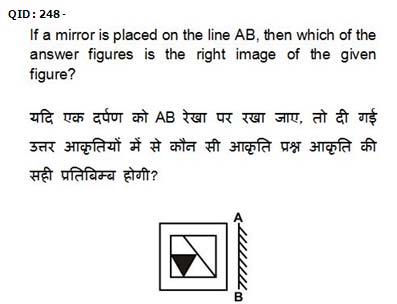

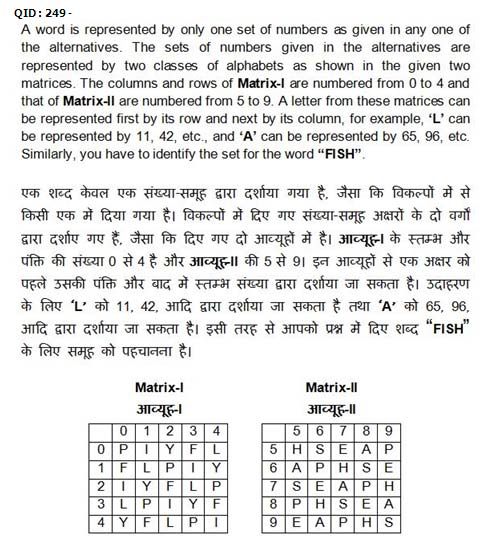
Options:
1) 66, 00, 68, 14, 76
2) 95, 44, 87, 33, 88
3) 89, 32, 75, 42, 69
4) 57, 13, 99, 20, 58
Correct Answer: [ No Correct Answer ]
QID. 250
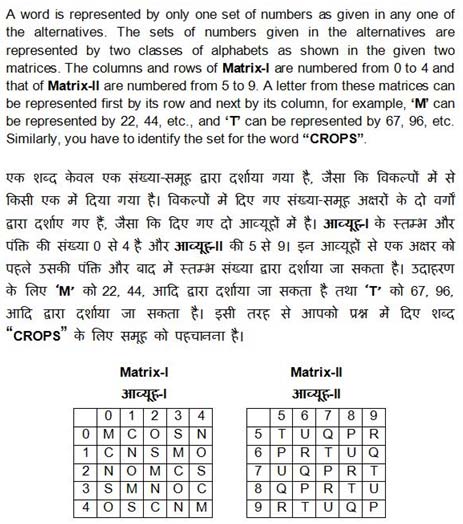
Options:
1) 13, 68, 10, 67, 40
2) 42, 89, 41, 85, 31
3) 34, 75, 33, 79, 20
4) 13, 56, 24, 95, 14
Correct Answer: [ No Correct Answer ]
Geography of India and The World
Oceans of the World
Oceans by Size
|
Pacific Ocean |
(35,827 ft) (10, 924 metres) |
|
Atlantic Ocean |
(30,246 ft) (9,219 metres) |
|
Indian Ocean |
(24,460 ft) (7,455 metres) |
|
Caribbean Sea |
(22,788 ft) (6,946 metres) |
|
Arctic Ocean |
(18,456 ft) (5,625 metres) |
|
South China Sea |
(16,456 ft) (5,016 metres) |
|
Bering Sea |
(15,659 ft) (4,773 metres) |
|
Mediterranean Sea |
(15,197 ft) (4,632 metres) |
|
Gulf of Mexico |
(12,425 ft) (3,787 metres) |
|
Japan Sea |
(12,276 ft) (3,742 metres) |
Oceans’ Greatest Depths
|
Mariana Trench, Pacific Ocean |
10,911 mt (Challenger Deep) |
|
Tonga Trench, Pacific Ocean, |
10,882 mt (VITYAZ 11) |
|
Phillippine Trench, Pacific Ocean, |
10,540 mt (Galathea Depth) |
|
Kuril-Kamchatka Trench, Pacific Ocean, |
10,500 mt |
|
Kermadec Trench, Pacific Ocean |
10,047 mt |
|
Japan Trench, Pacific Ocean |
9,000 mt |
|
Puerto Rico Trench, Atlantic Ocean |
8,6057 (Milwaukee Deep) |
|
Yap Trench, Pacific Ocean, |
8,527 mt |
|
South Sandwich Trench, Atlantic Ocean, |
8,428 mt |
|
Peru-Chile Trench, Pacific Ocean, |
8,065 mt |
SSC Courses and Programs:
Pages

|